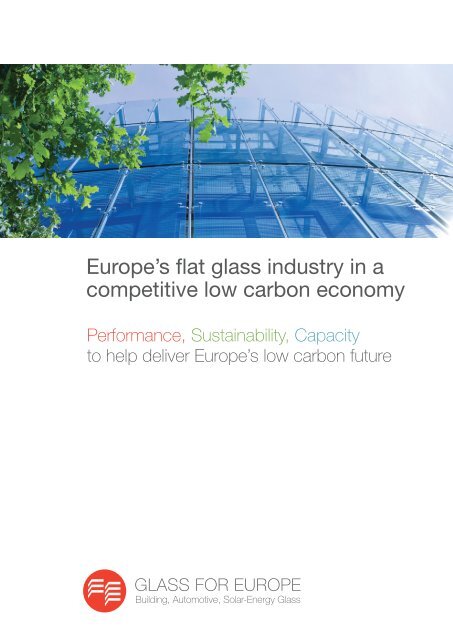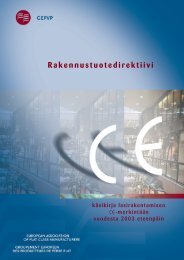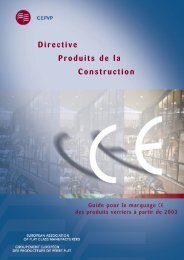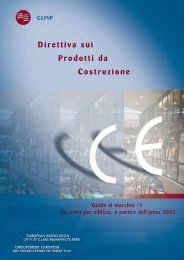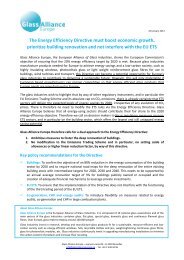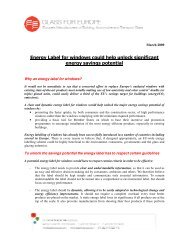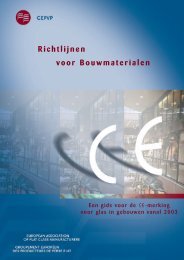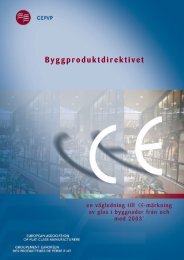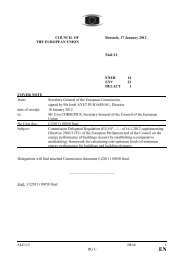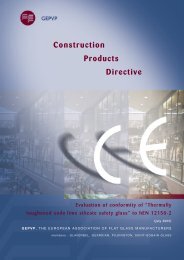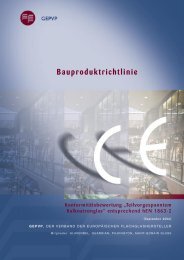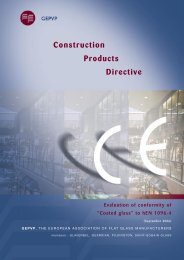Europe's flat glass industry in a competitive low ... - Glass for Europe
Europe's flat glass industry in a competitive low ... - Glass for Europe
Europe's flat glass industry in a competitive low ... - Glass for Europe
You also want an ePaper? Increase the reach of your titles
YUMPU automatically turns print PDFs into web optimized ePapers that Google loves.
<strong>Europe</strong>’s <strong>flat</strong> <strong>glass</strong> <strong><strong>in</strong>dustry</strong> <strong>in</strong> a<br />
<strong>competitive</strong> <strong>low</strong> carbon economy<br />
Per<strong>for</strong>mance, Susta<strong>in</strong>ability, Capacity<br />
to help deliver <strong>Europe</strong>’s <strong>low</strong> carbon future
This brochure has been produced and researched by <strong>Glass</strong> <strong>for</strong> <strong>Europe</strong>.<br />
Whilst every ef<strong>for</strong>t has been made to ensure the accuracy of the <strong>in</strong><strong>for</strong>mation,<br />
<strong>Glass</strong> <strong>for</strong> <strong>Europe</strong> does not accept responsibility <strong>for</strong> errors or omissions.<br />
Some pictures were provided by member companies of <strong>Glass</strong> <strong>for</strong> <strong>Europe</strong>.
Foreword by the Secretary General<br />
‘As of now, <strong>Europe</strong>’s <strong>flat</strong> <strong>glass</strong> <strong><strong>in</strong>dustry</strong> sets itself on a path to maximize its contributions to the <strong>Europe</strong>an 2050<br />
ambitions. (...) Our <strong><strong>in</strong>dustry</strong> <strong>in</strong>tends to deliver Per<strong>for</strong>mance, Susta<strong>in</strong>ability and the Production Capacities needed <strong>for</strong><br />
<strong>Europe</strong>’s <strong>low</strong> carbon future.’<br />
‘The <strong>flat</strong> <strong>glass</strong> <strong><strong>in</strong>dustry</strong>, through its products, its research and manufactur<strong>in</strong>g activities, and its susta<strong>in</strong>ability policy,<br />
has an active role to play <strong>in</strong> shap<strong>in</strong>g <strong>Europe</strong>’s future of a <strong>competitive</strong> <strong>low</strong> carbon economy.’<br />
In March 2011, the <strong>Europe</strong>an Commission presented its communication on “a Roadmap <strong>for</strong> mov<strong>in</strong>g to a<br />
<strong>competitive</strong> <strong>low</strong> carbon economy <strong>in</strong> 2050”. This Commission roadmap provides scenarios and targets on<br />
how sectors such as <strong><strong>in</strong>dustry</strong>, power generation, transport, build<strong>in</strong>gs, agriculture, etc. should undertake a<br />
transition towards a <strong>low</strong> carbon economy <strong>in</strong> the com<strong>in</strong>g years to achieve def<strong>in</strong>ed goals by 2050.<br />
Much talk has surrounded this so-called <strong>low</strong> carbon roadmap. What is already clear is that it provides direction<br />
<strong>for</strong> <strong>Europe</strong>. It def<strong>in</strong>es a horizon <strong>for</strong> <strong>Europe</strong>’s <strong><strong>in</strong>dustry</strong>, decision-makers and society at large to embrace.<br />
Achiev<strong>in</strong>g the objective of a <strong>competitive</strong> <strong>low</strong> carbon economy requires the mobilization of all stakeholders.<br />
<strong>Europe</strong>’s <strong>flat</strong> <strong>glass</strong> <strong><strong>in</strong>dustry</strong> hears that message and, as of now, sets itself on a path to maximize its<br />
contributions to the <strong>Europe</strong>an 2050 ambitions. This is the purpose of this <strong>flat</strong> <strong>glass</strong> <strong><strong>in</strong>dustry</strong>’s contribution<br />
to a <strong>competitive</strong> <strong>low</strong> carbon economy. It presents not only our <strong><strong>in</strong>dustry</strong>’s vision <strong>for</strong> 2050 but it most importantly<br />
highlights how our <strong><strong>in</strong>dustry</strong> will deliver Per<strong>for</strong>mance, Susta<strong>in</strong>ability and the Production Capacities<br />
needed <strong>for</strong> <strong>Europe</strong>’s <strong>low</strong> carbon future.<br />
The purpose of this contribution is neither to discuss the content of the Commission’s communication nor to<br />
def<strong>in</strong>e detailed positions on pieces of EU legislation. Rather, it sets out an <strong><strong>in</strong>dustry</strong> vision which can be<br />
achieved if supported by the right regulatory environment.<br />
We look <strong>for</strong>ward to work<strong>in</strong>g with all <strong>in</strong>terested parties who share our belief that the <strong>flat</strong> <strong>glass</strong> <strong><strong>in</strong>dustry</strong>,<br />
through its products, its research and manufactur<strong>in</strong>g activities and its susta<strong>in</strong>ability policy, has an<br />
active role to play <strong>in</strong> shap<strong>in</strong>g <strong>Europe</strong>’s future of a <strong>competitive</strong> <strong>low</strong> carbon economy.<br />
Bertrand Cazes,<br />
Secretary General of <strong>Glass</strong> <strong>for</strong> <strong>Europe</strong><br />
3
4<br />
picture
Table of Contents<br />
The <strong>flat</strong> <strong>glass</strong> <strong><strong>in</strong>dustry</strong>’s vision of a <strong>low</strong> carbon economy 6<br />
Flat <strong>glass</strong> products provide energy efficient solutions 8<br />
The contributions of the <strong>flat</strong> <strong>glass</strong> <strong><strong>in</strong>dustry</strong> to a <strong>competitive</strong> <strong>low</strong> carbon economy 10<br />
Deliver<strong>in</strong>g per<strong>for</strong>mance 12<br />
To provide <strong>Europe</strong> with net energy and CO2 sav<strong>in</strong>g products 13<br />
To guarantee that our products meet the highest per<strong>for</strong>mance <strong>in</strong> terms of safety, 15<br />
com<strong>for</strong>t, technology and aesthetics<br />
To ma<strong>in</strong>ta<strong>in</strong> a lead <strong>in</strong> Research & Development 16<br />
Plac<strong>in</strong>g susta<strong>in</strong>ability first <strong>in</strong> all activities and products 18<br />
To produce responsibly and <strong>in</strong> harmony with the environment 19<br />
To recycle and contribute to a resource efficient <strong>Europe</strong> 21<br />
To build susta<strong>in</strong>ability awareness along the value cha<strong>in</strong> 22<br />
Invest<strong>in</strong>g <strong>in</strong> state-of-the-art production capacity to meet <strong>Europe</strong>’s demand 26<br />
To ensure that <strong>Europe</strong>’s <strong>glass</strong> market is pr<strong>in</strong>cipally supplied by <strong>Europe</strong>an manufacturers 27<br />
To <strong>in</strong>vest <strong>in</strong> upgrad<strong>in</strong>g all <strong>Europe</strong>an plants to best available techniques 28<br />
To ensure the <strong>competitive</strong>ness of our <strong>Europe</strong>an operations to generate growth 29<br />
and green jobs <strong>in</strong> the EU<br />
www.<strong>glass</strong><strong>for</strong>europe.com<br />
5
The <strong>flat</strong> <strong>glass</strong> <strong><strong>in</strong>dustry</strong>’s vision<br />
of a <strong>low</strong> carbon economy<br />
1. A nearly-zero-energy build<strong>in</strong>g stock<br />
A 90% reduction <strong>in</strong> CO2 emissions by 2050 should be achieved<br />
Today, build<strong>in</strong>gs account <strong>for</strong> over 40% of primary energy consumption<br />
and 36% of <strong>Europe</strong>’s CO2 emissions. 2 As such they are the largest total<br />
emitters of CO2 but they also <strong>for</strong>m the sector <strong>in</strong> which most sav<strong>in</strong>gs<br />
can be realised. The EC road map suggests that a cut of 90% <strong>in</strong> CO2<br />
emissions from build<strong>in</strong>gs is necessary to achieve the EU’s <strong>low</strong> carbon<br />
objective. Studies have already demonstrated that this is achievable<br />
as the required technologies, <strong>in</strong>clud<strong>in</strong>g highly <strong>in</strong>sulat<strong>in</strong>g <strong>glass</strong> that<br />
offers a positive energy balance, already exist. The BPIE study<br />
‘<strong>Europe</strong>’s build<strong>in</strong>gs under the microscope’ 3 even def<strong>in</strong>ed the pathway<br />
to reach this objective at the <strong>low</strong>est upfront cost <strong>for</strong> Society and with<br />
the highest return on <strong>in</strong>vestment.<br />
The <strong>competitive</strong> <strong>low</strong> carbon economy will never be achieved if <strong>Europe</strong><br />
does not <strong>in</strong>vest heavily <strong>in</strong> the deep renovation of the exist<strong>in</strong>g build<strong>in</strong>g<br />
stock necessary to reach ‘nearly-zero‘ energy levels by 2050.<br />
The <strong>competitive</strong> <strong>low</strong> carbon<br />
economy will never be achieved<br />
if <strong>Europe</strong> does not <strong>in</strong>vest heavily<br />
<strong>in</strong> the deep renovation of the<br />
exist<strong>in</strong>g build<strong>in</strong>g stock<br />
2. Greener vehicles<br />
Faster deployment of technology must drive susta<strong>in</strong>able mobility<br />
Transport and road vehicles <strong>in</strong> particular are a major source of CO2<br />
emissions. It is there<strong>for</strong>e imperative that the automotive <strong><strong>in</strong>dustry</strong><br />
embraces all new technological developments that make vehicles<br />
more energy efficient. In addition to improvements <strong>in</strong> the efficiency of<br />
eng<strong>in</strong>es, new technologies <strong>in</strong> materials, such as <strong>glass</strong>, can also help<br />
contribute to greener vehicles. Research and development <strong>in</strong> these<br />
fields should be prioritised and the uptake of new products needs to be<br />
supported. Over the longer term, and as the deployment of electric<br />
vehicles <strong>in</strong>creases, <strong>in</strong>tegrat<strong>in</strong>g renewable energy sources <strong>in</strong>to vehicles<br />
may offer new opportunities, as illustrated by the gradual <strong>in</strong>troduction<br />
of photovoltaic cells on <strong>glass</strong> roof surfaces of some hybrid vehicles.<br />
New technologies <strong>in</strong> materials,<br />
such as <strong>glass</strong>, can also help<br />
contribute to greener vehicles<br />
Share of total EU energy consumption<br />
Transport<br />
33%<br />
Industrial processes<br />
21%<br />
Industrial build<strong>in</strong>gs<br />
7%<br />
Agriculture<br />
2%<br />
Build<strong>in</strong>gs (domestic & tertiary)<br />
37%<br />
6
The <strong>flat</strong> <strong>glass</strong> <strong><strong>in</strong>dustry</strong> supports the objective of mak<strong>in</strong>g <strong>Europe</strong> a <strong>competitive</strong> and <strong>low</strong> carbon economy as soon as possible. In fact,<br />
it believes that all sectors of the economy must contribute to achiev<strong>in</strong>g CO2 emission reductions by the horizon 2050. Based on the<br />
EU roadmap <strong>for</strong> a <strong>competitive</strong> and <strong>low</strong> carbon economy, 1 the <strong>flat</strong> <strong>glass</strong> <strong><strong>in</strong>dustry</strong> has a vision <strong>for</strong> the four sectors of the economy<br />
where it is active. This vision requires a high-level of ambition and <strong><strong>in</strong>dustry</strong> mobilization.<br />
3. Renewable energy to power <strong>Europe</strong><br />
Nearly all of <strong>Europe</strong>’s electricity should come from <strong>low</strong> carbon<br />
sources <strong>in</strong> 2050<br />
The <strong>low</strong> carbon objective implies a gradual electrification of <strong>Europe</strong>’s<br />
economy, with a move away from fossil fuel wherever technology<br />
al<strong>low</strong>s it. Only if electricity comes from <strong>low</strong> carbon sources, and renewable<br />
sources <strong>in</strong> particular, will this lead to decarbonisation. Photovoltaic<br />
technology has a central role to play <strong>in</strong> this transition. It can be implemented<br />
on a large scale <strong>in</strong> concentrated solar power stations, and<br />
of course <strong>in</strong> smaller units, such as photovoltaic panels on roofs and,<br />
<strong>in</strong>creas<strong>in</strong>gly, <strong>in</strong> build<strong>in</strong>g <strong>in</strong>tegrated photovoltaic facades, which can<br />
feed surplus electricity back <strong>in</strong>to the grid. In all these applications, <strong>glass</strong><br />
offers an ideal substrate to help generate and conduct electricity <strong>in</strong> the<br />
modules.<br />
Thanks to the deployment of smart grids and technology advances <strong>in</strong><br />
battery storage, it is possible <strong>for</strong> nearly all of <strong>Europe</strong>’s electricity to<br />
come from <strong>low</strong> carbon and renewable sources by 2050.<br />
<strong>Glass</strong> offers an ideal substrate to<br />
help generate and conduct electricity<br />
<strong>in</strong> photovoltaic modules<br />
4. An environmentally-friendly manufactur<strong>in</strong>g base<br />
<strong>Europe</strong> deserves the most energy efficient <strong>in</strong>dustrial processes<br />
The <strong>low</strong> carbon economy will only materialize if a strong and <strong>competitive</strong><br />
<strong>in</strong>dustrial base <strong>in</strong> <strong>Europe</strong> supports the objective by deliver<strong>in</strong>g<br />
the new products needed to renovate build<strong>in</strong>gs, generate energy or<br />
to manufacture new types of vehicles. These products must be manufactured<br />
<strong>in</strong> <strong>Europe</strong>:<br />
• to avoid carbon and energy embodied <strong>in</strong> imported products,<br />
• to ensure that <strong>Europe</strong>’s <strong>in</strong>dustries rema<strong>in</strong> at the <strong>for</strong>efront of green<br />
technology development<br />
• to provide jobs, manufactur<strong>in</strong>g and economic growth.<br />
How big a cut <strong>in</strong> <strong>in</strong>dustrial CO2 emissions is achievable ultimately<br />
depends on the type of <strong><strong>in</strong>dustry</strong>, the state of technological progress<br />
and the products manufactured. Unlike <strong>in</strong> the other sectors where<br />
energy sav<strong>in</strong>gs can serve as a useful <strong>in</strong>dicator, energy efficiency, which<br />
considers energy per output unit, must be placed at the core of the<br />
EU’s approach to <strong><strong>in</strong>dustry</strong> to avoid imped<strong>in</strong>g manufactur<strong>in</strong>g growth.<br />
Ensur<strong>in</strong>g that <strong>Europe</strong> profits from the most energy efficient manufactur<strong>in</strong>g<br />
processes, which deliver the advanced <strong>glass</strong> products that the <strong>low</strong><br />
carbon economy requires, is not only a vision but a commitment of the<br />
<strong>flat</strong> <strong>glass</strong> <strong><strong>in</strong>dustry</strong>.<br />
A strong and <strong>competitive</strong><br />
<strong>in</strong>dustrial base <strong>in</strong> <strong>Europe</strong> supports<br />
the objective by deliver<strong>in</strong>g the<br />
new products needed<br />
1<br />
<strong>Europe</strong>an Commission - A Roadmap <strong>for</strong> mov<strong>in</strong>g to a <strong>competitive</strong> <strong>low</strong> carbon economy <strong>in</strong> 2050 - COM(2011) 112 f<strong>in</strong>al – 8 March 201<br />
2<br />
Sources : Eurostat<br />
3<br />
BPIE – ‘<strong>Europe</strong>’s build<strong>in</strong>gs under the microscope’ – October 2011.<br />
7
Flat <strong>glass</strong> products provide<br />
energy efficient solutions<br />
<strong>Europe</strong>’s <strong>flat</strong> <strong>glass</strong> <strong><strong>in</strong>dustry</strong> is ready to provide solutions to enable <strong>Europe</strong> to achieve its objective of a<br />
<strong>competitive</strong> <strong>low</strong> carbon economy. These solutions lie <strong>in</strong> <strong>glass</strong> products themselves, which <strong>in</strong> their different<br />
applications are essential to reduce energy use and CO2 emissions.<br />
Glaz<strong>in</strong>g needs to be optimised to provide the best energy balance to build<strong>in</strong>gs<br />
Adequate use of highly <strong>in</strong>sulat<strong>in</strong>g glaz<strong>in</strong>g is essential to energy efficient build<strong>in</strong>gs<br />
<strong>Glass</strong> is unique amongst build<strong>in</strong>g materials because of its ability<br />
to provide natural light and solar heat. <strong>Glass</strong> there<strong>for</strong>e reduces the<br />
need <strong>for</strong> artificial light<strong>in</strong>g. It also transmits free solar heat ga<strong>in</strong>s <strong>in</strong>to<br />
build<strong>in</strong>gs to the extent that w<strong>in</strong>dows can be net contributors of<br />
energy. For these reasons, many architects specialis<strong>in</strong>g <strong>in</strong> <strong>low</strong> energy<br />
build<strong>in</strong>gs <strong>in</strong>corporate large glazed areas <strong>in</strong> their designs. Such daylit<br />
<strong>in</strong>teriors also result <strong>in</strong> <strong>in</strong>creased com<strong>for</strong>t, productivity, health and<br />
wellbe<strong>in</strong>g <strong>for</strong> the occupants.<br />
Outside<br />
Inside<br />
85% of the glazed surfaces <strong>in</strong> <strong>Europe</strong>’s build<strong>in</strong>gs conta<strong>in</strong> <strong>in</strong>efficient<br />
glaz<strong>in</strong>g. 4 The Dutch scientific <strong>in</strong>stitute TNO quantified that over 100<br />
million tonnes of CO2 could be saved annually if this were replaced<br />
with advanced glaz<strong>in</strong>g. 5 This represents more than a third of the EU’s<br />
20% energy sav<strong>in</strong>g commitment <strong>for</strong> 2020. It illustrates how vital it is <strong>for</strong><br />
<strong>Europe</strong> to upgrade the glaz<strong>in</strong>g of its build<strong>in</strong>g stock to achieve its <strong>low</strong><br />
carbon objectives.<br />
Be it <strong>in</strong> new construction or at the time of deep renovation of build<strong>in</strong>gs<br />
and homes, glaz<strong>in</strong>g needs to be optimised to provide the best energy<br />
balance to build<strong>in</strong>gs.<br />
Sun<br />
Internal heat<br />
Free solar<br />
heat ga<strong>in</strong><br />
In build<strong>in</strong>g <strong>glass</strong>, the solution has already been largely provided:<br />
the high-per<strong>for</strong>m<strong>in</strong>g glaz<strong>in</strong>g products that will make <strong>Europe</strong>’s<br />
build<strong>in</strong>gs nearly zero-energy are already available. The challenge<br />
<strong>for</strong> 2050 is to ensure that Society embraces these products and<br />
that they are properly used to deliver their full potential.<br />
It is thanks to the development of coated <strong>glass</strong> technologies that<br />
glazed surfaces and w<strong>in</strong>dows have developed these unique properties.<br />
In either double or triple glaz<strong>in</strong>g, modern <strong>in</strong>sulat<strong>in</strong>g <strong>glass</strong> units conta<strong>in</strong><br />
at least one pane hav<strong>in</strong>g a th<strong>in</strong> transparent coat<strong>in</strong>g, which <strong>in</strong>creases<br />
<strong>in</strong>sulation properties. These “Low-Emissivity” coat<strong>in</strong>gs help keep the<br />
warmth <strong>in</strong>side when it is cold outside, while captur<strong>in</strong>g the benefit of any<br />
solar heat. In warm climates, or where a build<strong>in</strong>g is air-conditioned,<br />
these coat<strong>in</strong>gs can also be given “solar control” properties, which al<strong>low</strong><br />
the daylight to pass through a w<strong>in</strong>dow or façade while radiat<strong>in</strong>g and<br />
reflect<strong>in</strong>g away a large degree of the sun’s heat so that the <strong>in</strong>door<br />
space stays bright and much cooler than with normal <strong>glass</strong>.<br />
Glaz<strong>in</strong>g type distribution <strong>in</strong> the EU<br />
Early uncoated<br />
Double glaz<strong>in</strong>g<br />
42%<br />
Modern Low-E coated<br />
Double glaz<strong>in</strong>g<br />
12%<br />
Triple glaz<strong>in</strong>g<br />
2%<br />
S<strong>in</strong>gle glaz<strong>in</strong>g<br />
44%<br />
8<br />
4<br />
TNO Built Environment and Geosciences – Glaz<strong>in</strong>g type distribution <strong>in</strong> the EU build<strong>in</strong>g stock – TNO report TNO-60-DTM-2011-00338 – February 2011.<br />
5<br />
TNO Built Environment and Geosciences – Potential impact of Low-Emissivity glaz<strong>in</strong>g on energy and CO2 sav<strong>in</strong>gs <strong>in</strong> <strong>Europe</strong> – TNO report 2008-D-R1240/B<br />
– November 2008.
<strong>Glass</strong> technologies are constantly be<strong>in</strong>g developed to cont<strong>in</strong>ue improv<strong>in</strong>g<br />
solar energy’s efficiency.<br />
<strong>Glass</strong> technologies offer new opportunities<br />
<strong>for</strong> solar energy<br />
<strong>Glass</strong> already plays an important role <strong>in</strong> the generation of solar<br />
power. It is already used <strong>in</strong> both photovoltaic modules and solar<br />
thermal panels to generate respectively electricity and hot water. So<br />
far, <strong>glass</strong> covers have primarily been used to protect panels and<br />
modules from outside conditions while lett<strong>in</strong>g the sunlight through to<br />
heat thermal collectors or to activate photovoltaic cells.<br />
<strong>Glass</strong> technologies are constantly be<strong>in</strong>g developed to cont<strong>in</strong>ue improv<strong>in</strong>g<br />
solar energy’s efficiency. For <strong>in</strong>stance, extra-clear <strong>glass</strong> coupled<br />
with anti-reflective coat<strong>in</strong>gs al<strong>low</strong>s more sunlight <strong>in</strong>to the module. The<br />
coated <strong>glass</strong> component of modules can also now serve to conduct<br />
the generated electricity outside of the modules. In addition, different<br />
shapes and colours are developed to al<strong>low</strong> more flexibility <strong>for</strong> design<br />
<strong>in</strong>tegration, particularly <strong>in</strong>to build<strong>in</strong>gs.<br />
Flat <strong>glass</strong> manufacturers make sure to constantly respond<br />
and exceed the per<strong>for</strong>mance requirements of the solar<br />
energy <strong><strong>in</strong>dustry</strong>. They also utilize all their expertise from<br />
the construction <strong><strong>in</strong>dustry</strong> to deliver durable solutions <strong>for</strong> the<br />
deployment of build<strong>in</strong>g <strong>in</strong>tegrated photovoltaic.<br />
Contribut<strong>in</strong>g to <strong>in</strong>novative, green<br />
and safe transport solutions<br />
<strong>Glass</strong> already contributes <strong>in</strong> different ways to the development of<br />
greener vehicles. With the development of lighter <strong>glass</strong> components<br />
<strong>for</strong> w<strong>in</strong>dshields, sidelights and backlights, the energy use<br />
and CO2 emissions of vehicles can be reduced. 6 However <strong>for</strong> the <strong>glass</strong><br />
<strong><strong>in</strong>dustry</strong>, the challenge is to succeed <strong>in</strong> reduc<strong>in</strong>g further the weight of<br />
these components while ensur<strong>in</strong>g the highest levels of safety and security<br />
<strong>for</strong> passengers and while mak<strong>in</strong>g sure that reduced <strong>glass</strong> weight<br />
does not imply recourse to heavier materials elsewhere to guarantee<br />
the structural <strong>in</strong>tegrity of vehicles. Thanks to new <strong>glass</strong> technologies,<br />
the average <strong>glass</strong> content of a passenger car has decreased to be<strong>low</strong><br />
3% by mass while the glazed surfaces have <strong>in</strong>creased <strong>in</strong> size to accommodate<br />
new aerodynamic designs.<br />
Automotive <strong>glass</strong> also uses coat<strong>in</strong>g technologies to further<br />
contribute to reduc<strong>in</strong>g fuel consumption. Solar control glaz<strong>in</strong>g<br />
helps m<strong>in</strong>imize solar heat <strong>in</strong>gress <strong>in</strong>to vehicles exposed to the sun and<br />
there<strong>for</strong>e considerably reduces the load on any air condition<strong>in</strong>g<br />
required to ma<strong>in</strong>ta<strong>in</strong> a com<strong>for</strong>table cab<strong>in</strong> temperature. S<strong>in</strong>ce aircondition<strong>in</strong>g<br />
equipment is a large energy consumer <strong>in</strong> road transport,<br />
this glaz<strong>in</strong>g technology al<strong>low</strong>s <strong>for</strong> reduced fuel consumption.<br />
In electric cars, glaz<strong>in</strong>g can play an even more important role. Reduc<strong>in</strong>g<br />
the power consumption of the com<strong>for</strong>t equipment which does not<br />
serve to power the vehicle itself helps <strong>in</strong> improv<strong>in</strong>g the range of electric<br />
vehicles. Furthermore the limitations of batteries <strong>in</strong> extreme conditions<br />
and the <strong>in</strong>tense power needed to heat or cool down cab<strong>in</strong>s, means<br />
light-weight glaz<strong>in</strong>g solutions with advanced thermal properties can<br />
make substantial differences to the range of vehicles between battery<br />
charges. As electric and hybrid vehicles become more common, the<br />
<strong>glass</strong> component of vehicles is likely to <strong>in</strong>corporate more solar cell<br />
technologies.<br />
6<br />
In fact, it is assumed that a reduction of 10kg of an average family car reduces the vehicle’s CO2 emissions by 0,8 g/km.<br />
Susta<strong>in</strong>able mobility is technology <strong>in</strong>tensive and requires many<br />
small improvements <strong>in</strong> all areas without wait<strong>in</strong>g <strong>for</strong> “blue sky<br />
developments”. Flat <strong>glass</strong> manufacturers have solutions ready<br />
to be implemented now to contribute to greener automobiles<br />
and beyond, to greener transport modes such as tra<strong>in</strong>s, trams<br />
and buses which use <strong>glass</strong>. By 2050, the use of automotive<br />
<strong>glass</strong> to generate motive power could become a normal fact of<br />
everyday life.<br />
9
The contributions of the <strong>flat</strong> <strong>glass</strong> <strong><strong>in</strong>dustry</strong><br />
to a <strong>competitive</strong> <strong>low</strong> carbon economy<br />
<strong>Glass</strong> products provide a wealth of ways to reduce CO2 emissions but it is essential <strong>for</strong> our <strong><strong>in</strong>dustry</strong> to<br />
capitalize on these benefits to fully realize the potential of a <strong>competitive</strong> <strong>low</strong> carbon economy. To that end,<br />
the <strong>flat</strong> <strong>glass</strong> <strong><strong>in</strong>dustry</strong> <strong>in</strong>tends to deliver Per<strong>for</strong>mance, Susta<strong>in</strong>ability and the Production Capacities<br />
needed <strong>for</strong> <strong>Europe</strong>’s <strong>low</strong> carbon future.<br />
This is much more than a motto. These are three essential contributions from the <strong>flat</strong> <strong>glass</strong> <strong><strong>in</strong>dustry</strong> which<br />
act as guid<strong>in</strong>g pr<strong>in</strong>ciples <strong>for</strong> the <strong><strong>in</strong>dustry</strong> to take its part <strong>in</strong> realiz<strong>in</strong>g <strong>Europe</strong>’s 2050 ambitions. It goes beyond<br />
the <strong>glass</strong> products themselves and covers the manufactur<strong>in</strong>g process. It illustrates the manufacturers’ will<br />
to responsibly produce <strong>in</strong> <strong>Europe</strong> the products that will shape <strong>Europe</strong>’s future.<br />
Deliver<strong>in</strong>g on these promises is an <strong>in</strong>dustrial challenge; that of the <strong>flat</strong> <strong>glass</strong> <strong><strong>in</strong>dustry</strong>. It is clear however that<br />
the regulatory environment will heavily <strong>in</strong>fluence the feasibility and timel<strong>in</strong>ess of the achievement of these<br />
goals. There<strong>for</strong>e we hope that <strong>Europe</strong>an authorities will support these ef<strong>for</strong>ts with adequate concrete policy<br />
measures.<br />
Per<strong>for</strong>mance, Susta<strong>in</strong>ability, Capacity<br />
to help deliver <strong>Europe</strong>’s <strong>low</strong> carbon future<br />
10
<strong>Glass</strong> <strong>for</strong> <strong>Europe</strong> and its member companies are committed to pursu<strong>in</strong>g the fol<strong>low</strong><strong>in</strong>g contributions to help<br />
shape <strong>Europe</strong>’s <strong>competitive</strong> <strong>low</strong> carbon economy:<br />
Deliver<strong>in</strong>g per<strong>for</strong>mance<br />
• To provide <strong>Europe</strong> with net Energy and CO 2 sav<strong>in</strong>g products<br />
• To guarantee that our products meet the highest per<strong>for</strong>mance <strong>in</strong> terms of safety,<br />
com<strong>for</strong>t, technology and aesthetics<br />
• To ma<strong>in</strong>ta<strong>in</strong> a lead <strong>in</strong> Research & Development<br />
Plac<strong>in</strong>g susta<strong>in</strong>ability first <strong>in</strong> all activities and products<br />
• To produce responsibly and <strong>in</strong> harmony with the environment<br />
• To recycle and contribute to a resource efficient <strong>Europe</strong><br />
• To build susta<strong>in</strong>ability awareness along the value cha<strong>in</strong><br />
Invest<strong>in</strong>g <strong>in</strong> state-of-the-art production capacity<br />
to meet <strong>Europe</strong>’s demand<br />
• To ensure that <strong>Europe</strong>’s <strong>glass</strong> market is pr<strong>in</strong>cipally supplied by <strong>Europe</strong>an manufacturers<br />
• To <strong>in</strong>vest <strong>in</strong> upgrad<strong>in</strong>g all <strong>Europe</strong>an plants to best available techniques<br />
• To ensure the <strong>competitive</strong>ness of our <strong>Europe</strong>an operations to generate growth and<br />
employment <strong>in</strong> the EU<br />
11
Deliver<strong>in</strong>g per<strong>for</strong>mance<br />
12
Our <strong><strong>in</strong>dustry</strong> is proud that <strong>glass</strong> products, throughout their life-cycle, are net energy savers.<br />
1. To provide <strong>Europe</strong> with net energy and CO 2 sav<strong>in</strong>g products<br />
Products made from <strong>flat</strong> <strong>glass</strong> are essential to the achievement of <strong>Europe</strong>’s <strong>low</strong> carbon objectives. This is<br />
due to the fact that <strong>in</strong> most of their applications, <strong>glass</strong> products help save energy and their contributions are<br />
<strong>in</strong>creas<strong>in</strong>gly be<strong>in</strong>g recognized by decision-makers.<br />
The <strong>Europe</strong>an Commission <strong>for</strong> <strong>in</strong>stance, <strong>in</strong> its recent Energy efficiency plan noted that ‘measures should be<br />
put <strong>in</strong> place to support the market uptake of efficient build<strong>in</strong>g components, <strong>for</strong> example... w<strong>in</strong>dows’. 7<br />
Throughout <strong>Europe</strong>, under the impetus of <strong>Europe</strong>an authorities, measures are be<strong>in</strong>g put <strong>in</strong> place or designed<br />
to support the uptake of energy efficient technologies and all these measures have the direct or <strong>in</strong>direct<br />
impact of encourag<strong>in</strong>g the use of energy efficient build<strong>in</strong>g <strong>glass</strong>:<br />
• The Recast energy per<strong>for</strong>mance<br />
of build<strong>in</strong>g directive will require<br />
all new constructions to achieve<br />
nearly-zero energy standards<br />
by 2020 and all renovation<br />
should achieve cost-optimal<br />
requirements, thus requir<strong>in</strong>g<br />
energy efficient glaz<strong>in</strong>g.<br />
• A <strong>Europe</strong>an energy labell<strong>in</strong>g<br />
scheme <strong>for</strong> w<strong>in</strong>dows is be<strong>in</strong>g<br />
considered fol<strong>low</strong><strong>in</strong>g the extension<br />
of the Energy labell<strong>in</strong>g<br />
directive to cover energy related<br />
products.<br />
• Many national energy efficiency<br />
action plans (NEEAPS) <strong>in</strong>clude<br />
economic and fiscal <strong>in</strong>centives<br />
to consumers to replace standard<br />
glaz<strong>in</strong>g with energy efficient<br />
glaz<strong>in</strong>g.<br />
• The Energy efficiency directive<br />
<strong>in</strong>troduces energy sav<strong>in</strong>g obligations<br />
<strong>for</strong> utilities and public<br />
build<strong>in</strong>g renovation requirements<br />
<strong>for</strong> Member States.<br />
This is only logical consider<strong>in</strong>g the high level of per<strong>for</strong>mance already achieved by the <strong>flat</strong> <strong>glass</strong> <strong><strong>in</strong>dustry</strong> <strong>in</strong><br />
develop<strong>in</strong>g <strong>in</strong>novative products that meet our modern society’s needs. But what is all the more important <strong>for</strong><br />
our <strong><strong>in</strong>dustry</strong> is our ability to provide <strong>Europe</strong> with products that, throughout their life-cycle, are net<br />
energy savers.<br />
Glaz<strong>in</strong>g <strong>in</strong>sulation per<strong>for</strong>mances: U g value<br />
S<strong>in</strong>gle glaz<strong>in</strong>g<br />
5,8<br />
Early uncoated<br />
double glaz<strong>in</strong>g<br />
Modern Low-E<br />
coated double glaz<strong>in</strong>g<br />
Coated triple glaz<strong>in</strong>g<br />
0,7<br />
1,1<br />
2,7<br />
13<br />
7<br />
<strong>Europe</strong>an Commission – Energy Efficiency Plan - COM(2011) 109 f<strong>in</strong>al – 8 March 2011.
CO 2 sav<strong>in</strong>gs are between 30 to 120 times greater than their embodied CO 2<br />
Ideal per<strong>for</strong>mance is achieved<br />
when a product saves far more<br />
CO2 dur<strong>in</strong>g its lifetime <strong>in</strong> use<br />
than it creates dur<strong>in</strong>g its manufacture.<br />
Based on life-cycle <strong>in</strong>ventory<br />
studies, the carbon content of<br />
energy efficient glaz<strong>in</strong>g units<br />
has been quantified. It can be<br />
correlated with the CO2 sav<strong>in</strong>gs<br />
result<strong>in</strong>g from the replacement of<br />
old glaz<strong>in</strong>g units with energy<br />
efficient double glazed units to<br />
provide outstand<strong>in</strong>g evidence<br />
that build<strong>in</strong>g <strong>glass</strong> products are<br />
net CO2 sav<strong>in</strong>g products.<br />
For <strong>in</strong>stance, calculations suggest<br />
that across <strong>Europe</strong> the total CO2<br />
equivalent generated by an energy<br />
efficient double glaz<strong>in</strong>g unit<br />
throughout its life-cyle is offset<br />
on average between 3 to 10 months<br />
only by the energy sav<strong>in</strong>gs realised<br />
compared to the same build<strong>in</strong>g<br />
equipped with s<strong>in</strong>gle glaz<strong>in</strong>g<br />
(<strong>in</strong> the shorter payback range) or<br />
early uncoated double glaz<strong>in</strong>g (<strong>in</strong><br />
the higher range). It must be<br />
noted that the payback period<br />
depends, among other factors,<br />
on the energetic mix of countries<br />
and of the heat<strong>in</strong>g needs. It is<br />
usually longer (up to 15 or 20<br />
months) when the product is <strong>in</strong>stalled<br />
<strong>in</strong> a build<strong>in</strong>g located <strong>in</strong> a<br />
warm climate like that of the very<br />
south of <strong>Europe</strong>. By us<strong>in</strong>g triple<br />
glaz<strong>in</strong>g, even more CO2 emissions<br />
can be avoided. For <strong>in</strong>stance,<br />
if it was used <strong>in</strong> all new<br />
constructions <strong>in</strong> Central and<br />
Northern <strong>Europe</strong>, CO2 emissions<br />
generated by the built environment<br />
would be reduced by an<br />
extra 10 million tonnes a year as<br />
of 2020. 8 These additional sav<strong>in</strong>gs<br />
significantly outweigh the extra<br />
CO2 emissions created by the<br />
production of triple glaz<strong>in</strong>g.<br />
Such CO2 payback times are extremely<br />
short when one considers<br />
that the full life-cycle is taken <strong>in</strong>to<br />
account and that w<strong>in</strong>dows stay<br />
on average 30 years <strong>in</strong> a residential<br />
dwell<strong>in</strong>g. When look<strong>in</strong>g at the<br />
overall CO2 impact of replac<strong>in</strong>g old<br />
and <strong>in</strong>efficient glaz<strong>in</strong>g units with<br />
energy efficient double glaz<strong>in</strong>g,<br />
CO2 sav<strong>in</strong>gs are between 30<br />
to 120 times greater than their<br />
embodied CO2.<br />
The above figures provide orders<br />
of magnitude <strong>for</strong> the residential<br />
sector only <strong>for</strong> the sole reason that<br />
many different parameters affect<br />
precise data. For this reasons,<br />
<strong>Glass</strong> <strong>for</strong> <strong>Europe</strong> prefers provid<strong>in</strong>g<br />
an order of magnitude know<strong>in</strong>g<br />
that the majority of calculations<br />
based on alternative data and<br />
assumptions will fall with<strong>in</strong> this<br />
range. The above figure have been<br />
calculated on the basis of average<br />
and conservative assumptions. 9<br />
The total CO 2 equivalent generated by an energy<br />
efficient double glaz<strong>in</strong>g unit throughout its life-cyle is offset<br />
on average between 3 to 10 months only.<br />
<strong>Europe</strong>’s <strong>flat</strong> <strong>glass</strong> <strong><strong>in</strong>dustry</strong> will use life-cycle th<strong>in</strong>k<strong>in</strong>g to deliver net energy and CO 2<br />
sav<strong>in</strong>g products. To do so, it will pursue both the challenge of further improv<strong>in</strong>g products’<br />
per<strong>for</strong>mances and that of br<strong>in</strong>g<strong>in</strong>g down the product carbon footpr<strong>in</strong>t. The same considerations<br />
will cont<strong>in</strong>ue to drive product development <strong>in</strong> other <strong>flat</strong> <strong>glass</strong> applications, be it<br />
<strong>in</strong> automotive and transport and even more so <strong>in</strong> solar energy <strong>glass</strong> used to provide a<br />
renewable source of energy.<br />
14<br />
8<br />
TNO Built Environment and Geosciences – Glaz<strong>in</strong>g type distribution <strong>in</strong> the EU build<strong>in</strong>g stock – TNO report TNO-60-DTM-2011-00338 – February 2011.<br />
9<br />
Among parameters affect<strong>in</strong>g these calculations, is the figure on embodied CO2. Many LCA studies on <strong>in</strong>sulat<strong>in</strong>g <strong>glass</strong> units provide different figures <strong>for</strong> embodied<br />
CO2. <strong>Glass</strong> <strong>for</strong> <strong>Europe</strong> tested its calculations on a range of data, some available <strong>in</strong> LCA databases, some based on Environmental Per<strong>for</strong>mance<br />
Declarations exist<strong>in</strong>g <strong>in</strong> some countries. The energy and CO2 sav<strong>in</strong>gs l<strong>in</strong>ked to energy-efficiency ga<strong>in</strong>s can also vary depend<strong>in</strong>g on climate, reference build<strong>in</strong>g,<br />
build<strong>in</strong>g usage, glaz<strong>in</strong>g orientation, previous glaz<strong>in</strong>g equipment <strong>in</strong> the build<strong>in</strong>g (i.e. s<strong>in</strong>gle glaz<strong>in</strong>g or early uncoated double glaz<strong>in</strong>g), space heat<strong>in</strong>g energy mix,<br />
CO2 conversion factors, calculations methods, etc. <strong>Glass</strong> <strong>for</strong> <strong>Europe</strong> has done its calculations on the basis of a reference apartment block with typical glaz<strong>in</strong>g<br />
area and orientations. Six climatic zones <strong>in</strong> the EU were computed and tested. Space heat<strong>in</strong>g energy mixes are based on <strong>in</strong><strong>for</strong>mation available <strong>in</strong> the literature<br />
and national CO2 conversion factors were used when available (if not the ELCD data was used). Some cross-checks with different assumptions (e.g. different<br />
build<strong>in</strong>g design, different reference climate, etc.) were carried.
2. To guarantee that our products meet the highest per<strong>for</strong>mance <strong>in</strong> terms of<br />
safety, com<strong>for</strong>t, technology and aesthetics<br />
<strong>Europe</strong>’s <strong>flat</strong> <strong>glass</strong> <strong><strong>in</strong>dustry</strong> ‘vision<br />
of a <strong>competitive</strong> <strong>low</strong> carbon<br />
economy’ is not limited to energy<br />
and climate considerations.<br />
The 2050 <strong>Europe</strong>an society will<br />
cont<strong>in</strong>ue request<strong>in</strong>g the highest<br />
levels of per<strong>for</strong>mance <strong>in</strong> terms of<br />
safety, com<strong>for</strong>t but also technology<br />
and aesthetics.<br />
Flat <strong>glass</strong> products are part of<br />
everyday life. We see, and see<br />
through them, all the time and<br />
they are part of the environment<br />
we live <strong>in</strong> and move with<strong>in</strong>. Safety,<br />
security and com<strong>for</strong>t will rema<strong>in</strong><br />
primary markers of per<strong>for</strong>mance<br />
<strong>for</strong> our <strong><strong>in</strong>dustry</strong>, be it <strong>in</strong> the area<br />
of build<strong>in</strong>g or automotive and<br />
transport.<br />
Our <strong><strong>in</strong>dustry</strong> believes the<br />
<strong>competitive</strong> <strong>low</strong> carbon economy<br />
can be the driver of a new<br />
technological era. Functional <strong>in</strong>tegration<br />
<strong>in</strong> <strong>flat</strong> <strong>glass</strong> products is<br />
likely to cont<strong>in</strong>ue as we have<br />
already seen <strong>in</strong> the <strong>in</strong>tegration of<br />
photovoltaic cells <strong>in</strong> both build<strong>in</strong>g<br />
and automotive <strong>glass</strong>.<br />
Look<strong>in</strong>g <strong>for</strong>ward <strong>flat</strong> <strong>glass</strong><br />
products offer a range of new<br />
possibilities thanks to the<br />
development of touch screen<br />
technologies and progress <strong>in</strong><br />
<strong>in</strong><strong>for</strong>mation technologies. The<br />
scope <strong>for</strong> <strong>Europe</strong>’s <strong>in</strong>novators is<br />
huge.<br />
Safety and security are paramount to automotive <strong>glass</strong><br />
Automotive <strong>glass</strong> is designed to last <strong>for</strong> the lifetime of a car –<br />
endur<strong>in</strong>g all weather conditions, wear and tear, wiper usage<br />
without excess of haze and scratches – and ma<strong>in</strong>ta<strong>in</strong><strong>in</strong>g all<br />
its safety and quality requirements <strong>in</strong> the event of accident or<br />
assault.<br />
Today safety is ensured by two types of glaz<strong>in</strong>g: toughened or<br />
lam<strong>in</strong>ated <strong>glass</strong>. Both toughened <strong>glass</strong> and lam<strong>in</strong>ated <strong>glass</strong> can be<br />
used <strong>in</strong> particular <strong>in</strong> side w<strong>in</strong>dows of cars to provide <strong>in</strong>creased levels of<br />
security and passenger com<strong>for</strong>t by <strong>in</strong>creas<strong>in</strong>g impact resistance and<br />
defence aga<strong>in</strong>st theft. With the use of lam<strong>in</strong>ated <strong>glass</strong>, <strong>in</strong> the case of<br />
impact <strong>in</strong> an accident, the <strong>glass</strong> will crack while absorb<strong>in</strong>g a large part<br />
of the energy from the impact<strong>in</strong>g body. S<strong>in</strong>ce the <strong>glass</strong> rema<strong>in</strong>s<br />
adhered to the plastic <strong>in</strong>terlayer, the w<strong>in</strong>dow stays <strong>in</strong> the frame act<strong>in</strong>g<br />
as a safety net and keep<strong>in</strong>g fragments away from the passengers.<br />
<strong>Glass</strong> also al<strong>low</strong>s people <strong>in</strong>jured <strong>in</strong> an accident to be easily freed.<br />
Lam<strong>in</strong>ated <strong>glass</strong> responds not only to the ma<strong>in</strong> safety concerns <strong>in</strong><br />
cars but it also helps reduce vehicle weight and improves thermal<br />
conditions with<strong>in</strong> vehicles to reduce their energy consumption.<br />
On the eve of a new technological era, <strong>Europe</strong>’s <strong>flat</strong> <strong>glass</strong> <strong><strong>in</strong>dustry</strong> will seek to guarantee<br />
the highest level of per<strong>for</strong>mance of its products <strong>for</strong> all their relevant characteristics.<br />
It will <strong>in</strong>vestigate new applications <strong>for</strong> <strong>glass</strong> which meet Society’s needs and will ensure<br />
that these are not developed at the expense of energy and CO 2 sav<strong>in</strong>g <strong>in</strong>herent per<strong>for</strong>mances<br />
of <strong>glass</strong> products.<br />
15
3. To ma<strong>in</strong>ta<strong>in</strong> a lead <strong>in</strong> Research & Development<br />
Research and development of new <strong>glass</strong> products that meet the needs of a <strong>low</strong> carbon society is a priority<br />
<strong>for</strong> the <strong>flat</strong> <strong>glass</strong> <strong><strong>in</strong>dustry</strong>. In fact, <strong>Glass</strong> <strong>for</strong> <strong>Europe</strong> member companies spend annually hundreds of<br />
million Euros <strong>in</strong> R&D. These R&D ef<strong>for</strong>ts cover all aspects of <strong>glass</strong> technologies from the development of<br />
new products and new functionalities to m<strong>in</strong>imiz<strong>in</strong>g the environmental impacts of manufactur<strong>in</strong>g facilities.<br />
Striv<strong>in</strong>g to develop cutt<strong>in</strong>g-edge <strong>flat</strong> <strong>glass</strong> products <strong>for</strong> the build<strong>in</strong>g, automotive and solar energy sectors,<br />
means pr<strong>in</strong>cipally look<strong>in</strong>g <strong>for</strong> ways to further improve the basic per<strong>for</strong>mances of <strong>flat</strong> <strong>glass</strong> products.<br />
Research fields there<strong>for</strong>e cover topics as diverse as:<br />
• <strong>in</strong>creas<strong>in</strong>g the <strong>in</strong>sulation and solar control properties<br />
of build<strong>in</strong>g and automotive <strong>glass</strong>;<br />
• enhanc<strong>in</strong>g the per<strong>for</strong>mance of <strong>glass</strong> products <strong>for</strong><br />
fire resistance and protection;<br />
• improv<strong>in</strong>g the com<strong>for</strong>t, aesthetic and noise pollution<br />
prevention qualities of <strong>glass</strong>;<br />
• reduc<strong>in</strong>g the weight of automotive <strong>glass</strong> while rais<strong>in</strong>g<br />
the safety and security standards<br />
• develop<strong>in</strong>g <strong>glass</strong> solutions that <strong>in</strong>tegrate PV cells<br />
to help power electric vehicles;<br />
• strengthen<strong>in</strong>g the anti-reflective properties of highlight<br />
transmission <strong>glass</strong> to generate more solar<br />
electricity<br />
Flat <strong>glass</strong> manufacturers are dedicated to br<strong>in</strong>g<strong>in</strong>g useful <strong>in</strong>novative solutions to the <strong>Europe</strong>an market and<br />
that is why new functionalities and applications <strong>for</strong> <strong>flat</strong> <strong>glass</strong> products are also researched, such as<br />
OLEDs light<strong>in</strong>g technologies.<br />
For these <strong>in</strong>dustrial ef<strong>for</strong>ts to pay-back <strong>for</strong> companies, and to create added-value <strong>in</strong> <strong>Europe</strong>, it is fundamentally<br />
important that new <strong>in</strong>novative products can quickly enter markets. Because energy efficiency<br />
and susta<strong>in</strong>ability will be critical success factors <strong>for</strong> <strong>in</strong>novations, the <strong>flat</strong> <strong>glass</strong> <strong><strong>in</strong>dustry</strong> is ready to work with<br />
<strong>Europe</strong>an authorities to ensure that the adequate policy <strong>in</strong>struments such as energy labell<strong>in</strong>g, eco-labell<strong>in</strong>g<br />
or eco-design, are used <strong>in</strong>telligently and more rapidly to reward R&D ef<strong>for</strong>ts by provid<strong>in</strong>g a market stimulus<br />
<strong>for</strong> high-per<strong>for</strong>mance products.<br />
M<strong>in</strong>imis<strong>in</strong>g the environmental impacts of production and products translates <strong>in</strong>to the research and<br />
development field as well. For <strong>in</strong>stance, <strong>in</strong> the automotive <strong>glass</strong> sector, millions of Euros are be<strong>in</strong>g spent to<br />
develop alternatives to lead-based solder<strong>in</strong>g of antennae to <strong>glass</strong> <strong>in</strong> vehicles. Special care is constantly<br />
given to product development so that the recyclability of products is ensured. Last but not least, thanks to<br />
R&D ef<strong>for</strong>ts, every newly built float <strong>glass</strong> <strong>in</strong>stallation is made ever more environmentally friendly and new<br />
furnace designs will cont<strong>in</strong>ue to be developed.<br />
OLEDs & <strong>glass</strong> substrates: a new <strong>for</strong>m of light<strong>in</strong>g<br />
Organic Light Emitt<strong>in</strong>g Diodes, OLEDs,<br />
emit light due to electrolum<strong>in</strong>escence and<br />
offer <strong>in</strong>creased energy efficiency over today’s<br />
light<strong>in</strong>g technologies. OLEDs can easily be<br />
fabricated on a <strong>glass</strong> substrate, which offers<br />
the benefits of a fully recyclable support<br />
material that can be <strong>in</strong>tegrated <strong>in</strong>to build<strong>in</strong>g<br />
designs and maximises the lifetime of the<br />
OLED device.<br />
This technology, which is be<strong>in</strong>g further<br />
developed <strong>in</strong>to f<strong>in</strong>al products, will offer a<br />
new way of provid<strong>in</strong>g artificial light <strong>in</strong>to build<strong>in</strong>gs<br />
when the natural light al<strong>low</strong>ed <strong>in</strong>to the<br />
<strong>in</strong>terior by glazed surfaces is fall<strong>in</strong>g. In addition,<br />
any <strong>glass</strong> surface could become a source<br />
of artificial light of a very pure and warm<br />
nature, whilst consum<strong>in</strong>g less energy than<br />
with current technology.<br />
Per<strong>for</strong>mance <strong>in</strong> the field of research and development is a pre-requisite <strong>for</strong> the <strong>flat</strong> <strong>glass</strong><br />
<strong><strong>in</strong>dustry</strong> to deliver solutions <strong>for</strong> <strong>Europe</strong>’s transition to a <strong>competitive</strong> <strong>low</strong> carbon economy.<br />
<strong>Europe</strong>, thanks to its skilled work<strong>for</strong>ce, its tradition and centres of excellence, is and will<br />
cont<strong>in</strong>ue to rema<strong>in</strong> on the <strong>flat</strong> <strong>glass</strong> <strong><strong>in</strong>dustry</strong>’s map <strong>for</strong> R&D centres and <strong>in</strong>vestments.<br />
16
A Supportive <strong>Europe</strong>an Policy Framework<br />
• In order to give substance to the 2050 <strong>competitive</strong> <strong>low</strong> carbon economy roadmap,<br />
<strong>in</strong>terim energy efficiency targets <strong>for</strong> the build<strong>in</strong>g and automotive sectors, and robust<br />
monitor<strong>in</strong>g systems, must be put <strong>in</strong> place <strong>for</strong> 2020, 2030 and 2040. This is essential to<br />
provide a long term framework <strong>for</strong> <strong><strong>in</strong>dustry</strong> to plan and <strong>in</strong>vest with confidence, and to<br />
mobilize society at large.<br />
• Beyond support <strong>for</strong> R&D projects, <strong>Europe</strong> needs to ensure that its <strong>in</strong>novative <strong>in</strong>dustries<br />
can be rewarded <strong>for</strong> their research <strong>in</strong>vestments and active contributions to the<br />
<strong>competitive</strong> <strong>low</strong> carbon economy objective.<br />
• Be it <strong>in</strong> transport, build<strong>in</strong>g or solar energy, the <strong>Europe</strong>an Union should ensure that<br />
its product policy is developed more rapidly and updated more often to ensure that<br />
measures always benefit state of the art products. It is essential that policy <strong>in</strong>struments<br />
such as energy labell<strong>in</strong>g, eco-labell<strong>in</strong>g, green public procurement criteria, etc. become<br />
more reactive to ensure that <strong>in</strong>novation is rewarded.<br />
• The concept of energy and resources embodied <strong>in</strong> products <strong>in</strong> isolation must be<br />
abandoned and replaced by real life-cycle analysis of products. Robust and reliable<br />
methodologies need to be created and guidel<strong>in</strong>es must be developed to adequately<br />
take account of the sav<strong>in</strong>g potential of products dur<strong>in</strong>g their use phase.<br />
• <strong>Europe</strong> should strengthen its policy to support the renovation of <strong>Europe</strong>’s build<strong>in</strong>g<br />
stock with concrete legislative tools and more robust implementation of exist<strong>in</strong>g<br />
<strong>in</strong>struments, such as the Energy per<strong>for</strong>mance of build<strong>in</strong>gs directive. Much greater EU<br />
funds must be mobilized to triple the rate at which <strong>Europe</strong>’s build<strong>in</strong>gs undergo deep<br />
renovation whilst preserv<strong>in</strong>g our cultural heritage.<br />
• <strong>Europe</strong> needs to ensure a proper function<strong>in</strong>g of the s<strong>in</strong>gle market to avoid market<br />
access delays generated by eventual national obstructions. To that end, <strong>Europe</strong>an<br />
authorities need to ensure that they ma<strong>in</strong>ta<strong>in</strong> and en<strong>for</strong>ce str<strong>in</strong>gent <strong>Europe</strong>an and/or<br />
<strong>in</strong>ternational <strong>glass</strong> product standards.<br />
17
Plac<strong>in</strong>g susta<strong>in</strong>ability first<br />
<strong>in</strong> all activities and products<br />
18
For <strong>Europe</strong>’s <strong>flat</strong> <strong>glass</strong> <strong><strong>in</strong>dustry</strong>, susta<strong>in</strong>ability goes way beyond concentrat<strong>in</strong>g on climate<br />
considerations. Produc<strong>in</strong>g <strong>in</strong> a susta<strong>in</strong>able manner also means m<strong>in</strong>imis<strong>in</strong>g all environmental impacts,<br />
by way of reduc<strong>in</strong>g the use of primary raw materials and substitut<strong>in</strong>g the use of hazardous<br />
substances, <strong>for</strong> example. It also requires ef<strong>for</strong>ts to ensure the highest levels of health and safety<br />
<strong>for</strong> workers and to educate customers down the supply cha<strong>in</strong> to use our products responsibly.<br />
1. To produce responsibly and <strong>in</strong> harmony with the environment<br />
One of the ma<strong>in</strong> environmental<br />
impacts of <strong>flat</strong> <strong>glass</strong> manufactur<strong>in</strong>g<br />
is l<strong>in</strong>ked to the use of energy.<br />
This impact is discussed separately<br />
on page 28. However, the<br />
<strong>flat</strong> <strong>glass</strong> <strong><strong>in</strong>dustry</strong> is committed to<br />
reduc<strong>in</strong>g all environmental impacts<br />
of its products and production<br />
facilities. In fact, if most of the<br />
other environmental impacts are<br />
relatively limited, it is thanks to all<br />
ef<strong>for</strong>ts already undertaken by <strong>flat</strong><br />
<strong>glass</strong> manufacturers.<br />
Today, nearly all float <strong>glass</strong><br />
manufactur<strong>in</strong>g <strong>in</strong>stallations <strong>in</strong><br />
<strong>Europe</strong> are certified to ISO-<br />
14001 and/or EMAS, the EU<br />
Eco-Management Audit Scheme,<br />
which illustrates the robustness<br />
of the environmental management<br />
systems put <strong>in</strong> place by<br />
the <strong><strong>in</strong>dustry</strong>. They cover a wide<br />
variety of aspects as illustrated<br />
be<strong>low</strong>.<br />
The use of hazardous substances<br />
and <strong>in</strong> particular of substances<br />
classified as substances of very<br />
high concern (SVHC) is a priority<br />
focus of care <strong>in</strong> the <strong><strong>in</strong>dustry</strong>. For<br />
certa<strong>in</strong> specific <strong>glass</strong> products,<br />
hazardous substances may<br />
sometimes be used <strong>in</strong> the production<br />
process. Despite <strong>in</strong>tensive<br />
research, it might not always<br />
be possible to completely rule<br />
these substances out, as may be<br />
the case <strong>for</strong> specific applications<br />
<strong>in</strong> solar energy <strong>glass</strong>.<br />
The <strong>flat</strong> <strong>glass</strong> <strong><strong>in</strong>dustry</strong> is committed to reduc<strong>in</strong>g all environmental impacts<br />
of its products and production facilities.<br />
Examples of environmental impact reduction ef<strong>for</strong>ts <strong>in</strong> <strong>glass</strong> manufactur<strong>in</strong>g<br />
• Air emissions: Beyond CO2, the further reduction of NOx, SOx and<br />
HCl is a primary objective of <strong>glass</strong> manufacturers. The challenge <strong>for</strong><br />
the <strong><strong>in</strong>dustry</strong> is to achieve greater reduction while avoid<strong>in</strong>g adverse<br />
effects s<strong>in</strong>ce certa<strong>in</strong> techniques may impact on other pollutants.<br />
When it comes to dust, the <strong>in</strong>troduction of dust filters <strong>in</strong> plants <strong>in</strong> the<br />
last twenty years and other abatement techniques have already<br />
helped reduce drastically most of these emissions.<br />
• Water consumption: In the <strong>flat</strong> <strong>glass</strong> <strong><strong>in</strong>dustry</strong>, water usage is limited<br />
and mostly directed at the cool<strong>in</strong>g of <strong>in</strong>stallations. For this reason,<br />
water is often used <strong>in</strong> close loop. Reduc<strong>in</strong>g and reus<strong>in</strong>g water rema<strong>in</strong>s<br />
an objective <strong>for</strong> the <strong><strong>in</strong>dustry</strong>. In the few applications which require<br />
that water is <strong>in</strong> contact with possible pollutants, the <strong>in</strong>stallation<br />
of water treatment <strong>in</strong>stallations is considered as a best practice which<br />
is effectively implemented.<br />
• Waste management: In <strong>flat</strong> <strong>glass</strong> manufactur<strong>in</strong>g, 90% of the waste<br />
generated is of a non-hazardous nature and levels of waste are relatively<br />
<strong>low</strong>. Much ef<strong>for</strong>t is placed <strong>in</strong> further reduc<strong>in</strong>g quantities and<br />
ensur<strong>in</strong>g that all rema<strong>in</strong><strong>in</strong>g waste is recycled.<br />
• Transport: Whenever possible, <strong>flat</strong> <strong>glass</strong> manufacturers favour the<br />
local supply of raw materials and alternative solutions to road transport,<br />
such as water and rail transport.<br />
• Packag<strong>in</strong>g: Transport<strong>in</strong>g <strong>flat</strong> <strong>glass</strong> requires specially-designed equipment.<br />
Steel stillages, which can be reused, now predom<strong>in</strong>ate <strong>in</strong> the<br />
EU <strong>flat</strong> <strong>glass</strong> <strong><strong>in</strong>dustry</strong> and when wood packag<strong>in</strong>g is necessary, <strong>flat</strong><br />
<strong>glass</strong> companies try to favour wood com<strong>in</strong>g from certified sources.<br />
19
The <strong>flat</strong> <strong>glass</strong> <strong><strong>in</strong>dustry</strong> will<br />
cont<strong>in</strong>ue look<strong>in</strong>g <strong>for</strong> suitable<br />
alternatives to hazardous<br />
substances. Under the REACH<br />
regulation, <strong>glass</strong> is a UVCB substance<br />
10 which is generally exempt<br />
from registration. For the products<br />
put on the market, i.e. ‘articles’,<br />
<strong>flat</strong> <strong>glass</strong> manufacturers will<br />
cont<strong>in</strong>ue avoid<strong>in</strong>g that any hazardous<br />
components are present.<br />
Should it however become the<br />
case, the <strong>flat</strong> <strong>glass</strong> <strong><strong>in</strong>dustry</strong> will<br />
always ensure that these components<br />
cannot be released to the<br />
soil, air or water environment and<br />
are there<strong>for</strong>e not available.<br />
Produc<strong>in</strong>g responsibly also<br />
requires that workers are guaranteed<br />
the highest level of<br />
health and safety <strong>in</strong> plants.<br />
Because <strong>glass</strong> is made with<br />
crystall<strong>in</strong>e silica, a type of sand<br />
that is ubiquitous <strong>in</strong> nature, measures<br />
are put <strong>in</strong> place to ensure<br />
that workers do not <strong>in</strong>hale f<strong>in</strong>e<br />
dust.<br />
For <strong>in</strong>stance, risk reduction<br />
measures and closed systems<br />
are developed to limit workers’<br />
exposure to dust. Additionally,<br />
collective and <strong>in</strong>dividual protective<br />
measures can also be put <strong>in</strong><br />
place and workers are submitted<br />
to regular health checks. The <strong>flat</strong><br />
<strong>glass</strong> <strong><strong>in</strong>dustry</strong> is a signatory of the<br />
NEPSI <strong>Europe</strong>an social dialogue<br />
<strong>in</strong> order to share and cont<strong>in</strong>ue<br />
apply<strong>in</strong>g best practices, <strong>in</strong> cooperation<br />
with employees unions.<br />
10<br />
Accord<strong>in</strong>g to the REACH regulation, <strong>Glass</strong> is a substance of ‘unknown or variable composition, complex reaction products or biological materials’. <strong>Glass</strong> is not a<br />
“mixture’. The raw materials are completely consumed dur<strong>in</strong>g the manufactur<strong>in</strong>g process <strong>in</strong> a set of chemical reactions so that they are no longer present <strong>in</strong> the<br />
newly <strong>for</strong>med <strong>glass</strong> substance.<br />
<strong>Europe</strong>’s <strong>flat</strong> <strong>glass</strong> <strong><strong>in</strong>dustry</strong> will <strong>in</strong>tensify its ef<strong>for</strong>ts to ensure that all its plants<br />
operate state-of-the-art environmental management systems that deliver cont<strong>in</strong>uous<br />
environmental improvements. In do<strong>in</strong>g so, the <strong><strong>in</strong>dustry</strong> will progressively apply best<br />
available technologies as described <strong>in</strong> the new BREF document <strong>for</strong> <strong>glass</strong> manufactur<strong>in</strong>g,<br />
established <strong>in</strong> the framework of the Industrial emissions directive.<br />
20
2. To recycle and contribute to a resource efficient <strong>Europe</strong><br />
One of the objectives of the 2050<br />
<strong>competitive</strong> <strong>low</strong> carbon economy<br />
is to protect natural resources<br />
and ensure that these are used<br />
only when necessary. In this context,<br />
recycl<strong>in</strong>g will be of vital<br />
importance <strong>for</strong> <strong>in</strong>dustries. In the<br />
<strong>flat</strong> <strong>glass</strong> sector, recyclability and<br />
recycl<strong>in</strong>g is already a reality but<br />
the product’s end-of-life management<br />
rema<strong>in</strong>s to be improved.<br />
<strong>Glass</strong> products have long been<br />
recyclable and the <strong><strong>in</strong>dustry</strong> ensures<br />
that new products launched<br />
on the market ma<strong>in</strong>ta<strong>in</strong> this fundamental<br />
characteristic.<br />
Beyond recyclability, the <strong>flat</strong> <strong>glass</strong><br />
<strong><strong>in</strong>dustry</strong> is will<strong>in</strong>g to <strong>in</strong>crease the<br />
quantity of recycled <strong>glass</strong>, named<br />
‘cullet’, <strong>in</strong> its production processes.<br />
The use of cullet helps save<br />
natural resources but it also offers<br />
additional benefits. Because recycled<br />
<strong>glass</strong> requires less energy<br />
to melt, it also contributes to reduc<strong>in</strong>g<br />
energy consumption and CO2<br />
emissions from manufactur<strong>in</strong>g<br />
plants. Today, float <strong>glass</strong> usually<br />
conta<strong>in</strong>s at least 20% cullet,<br />
which represents more than 5<br />
million tonnes of recycled <strong>glass</strong><br />
used annually <strong>in</strong> <strong>Europe</strong>’s float<br />
<strong>glass</strong> operations.<br />
Most of the cullet used <strong>in</strong> <strong>flat</strong><br />
<strong>glass</strong> manufactur<strong>in</strong>g usually orig<strong>in</strong>ates<br />
from the <strong>glass</strong> production,<br />
process<strong>in</strong>g or re-process<strong>in</strong>g processes<br />
such as off-cuts, losses<br />
dur<strong>in</strong>g lam<strong>in</strong>at<strong>in</strong>g, bend<strong>in</strong>g, <strong>in</strong>sulat<strong>in</strong>g<br />
<strong>glass</strong> unit fabrication, etc.<br />
These ‘by-products’ and/or waste<br />
usually have the required quality<br />
levels to be recycled to produce<br />
quality float <strong>glass</strong>.<br />
Despite its recyclability, postconsumer<br />
/ end-of-life waste<br />
<strong>flat</strong> <strong>glass</strong> is not recycled as much<br />
as desired. In many Member<br />
States, most of the construction,<br />
renovation and demolition<br />
<strong>glass</strong> waste simply ends up <strong>in</strong><br />
landfills due to its <strong>low</strong> value, its<br />
<strong>in</strong>ert characteristic and a lack<br />
of properly organised collection<br />
systems. <strong>Europe</strong>’s <strong>flat</strong> <strong>glass</strong><br />
<strong><strong>in</strong>dustry</strong> is ready to work closely<br />
with <strong>Europe</strong>an authorities to<br />
improve the situation, which<br />
will require remov<strong>in</strong>g regulatory<br />
hurdles that jeopardise the<br />
renovation and demolition <strong>glass</strong><br />
recycl<strong>in</strong>g route.<br />
Build<strong>in</strong>g demolition waste <strong>glass</strong>: the recycl<strong>in</strong>g route<br />
<strong>Glass</strong> wool<br />
& fibres<br />
Bottles<br />
& jars<br />
W<strong>in</strong>dows<br />
& facades<br />
UNDER<br />
DISMANTLING<br />
<strong>Glass</strong> must be dismantled<br />
from build<strong>in</strong>g be<strong>for</strong>e demolition<br />
<strong>Glass</strong> needs to be segregated<br />
from other build<strong>in</strong>g components<br />
The <strong><strong>in</strong>dustry</strong> is committed to<br />
play<strong>in</strong>g its part <strong>in</strong> achiev<strong>in</strong>g<br />
<strong>Europe</strong>’s objective of recycl<strong>in</strong>g<br />
70% of build<strong>in</strong>g demolition<br />
waste by 2020.<br />
For <strong>glass</strong>, this means <strong>in</strong> practice<br />
ensur<strong>in</strong>g that throughout <strong>Europe</strong><br />
and at any demolition or renovation<br />
site, <strong>glass</strong> waste is properly<br />
dismantled, separated, sorted<br />
and sent back to recyclers. Down<br />
the l<strong>in</strong>e, recyclers must clean<br />
waste <strong>glass</strong> of any impurity and<br />
be able to deliver cullet meet<strong>in</strong>g<br />
the <strong><strong>in</strong>dustry</strong>’s quality specifications<br />
back to <strong>glass</strong> plants.<br />
Cullet is <strong>in</strong>troduced <strong>in</strong><br />
furnaces of the different<br />
<strong>glass</strong> sectors to produce<br />
new <strong>glass</strong> with m<strong>in</strong>imal<br />
environmental impacts<br />
<strong>Glass</strong> is collected<br />
and sent to <strong>glass</strong><br />
recycl<strong>in</strong>g companies<br />
<strong>for</strong> treatment<br />
In a closed loop route, the most<br />
str<strong>in</strong>gent standards must be met<br />
<strong>for</strong> cullet to be sent back to <strong>flat</strong><br />
<strong>glass</strong> plants, due to the <strong>low</strong> tolerance<br />
to impurities of float <strong>glass</strong><br />
mak<strong>in</strong>g. Alternatively, cullet can<br />
be recycled <strong>in</strong>to conta<strong>in</strong>er <strong>glass</strong>,<br />
<strong>glass</strong> fibres and <strong>glass</strong> wool.<br />
Depend<strong>in</strong>g on the quality of<br />
cullet, it is used by different<br />
<strong>glass</strong> sectors. Flat <strong>glass</strong> mak<strong>in</strong>g<br />
requires the highest quality<br />
<strong>Glass</strong> is cleaned from<br />
impurities to become<br />
‘cullet’, i.e. recycled <strong>glass</strong><br />
Float <strong>glass</strong> usually conta<strong>in</strong>s at least 20% recycled content.<br />
21
For this promise to materialize,<br />
<strong>Europe</strong>an authorities will also<br />
have a role to play. Indeed, such<br />
ef<strong>for</strong>ts will mean additional costs<br />
<strong>for</strong> <strong>Europe</strong>’s <strong>flat</strong> <strong>glass</strong> <strong><strong>in</strong>dustry</strong><br />
and so it will be important to<br />
ensure that they do not jeo-<br />
pardize the level play<strong>in</strong>g field<br />
between EU-based and outside<br />
EU <strong>in</strong>dustries.<br />
In the longer term, the <strong>flat</strong> <strong>glass</strong><br />
<strong><strong>in</strong>dustry</strong> wishes to benefit from<br />
<strong>in</strong>creased cullet availability<br />
<strong>for</strong> its manufactur<strong>in</strong>g process.<br />
For this reason, <strong>Europe</strong>an manufacturers<br />
are also actively look<strong>in</strong>g<br />
<strong>for</strong> solutions to the ma<strong>in</strong> technical<br />
concern, which is that of <strong>in</strong>creas<strong>in</strong>g<br />
recycled content while safeguard<strong>in</strong>g<br />
the production quality.<br />
Impurities <strong>in</strong> <strong>glass</strong> cullet affect<br />
product quality and strength, thus<br />
potentially rais<strong>in</strong>g safety concerns<br />
<strong>for</strong> some products. Impurities <strong>in</strong><br />
<strong>glass</strong> cullet can also seriously<br />
damage manufactur<strong>in</strong>g <strong>in</strong>stallations.<br />
In the <strong>flat</strong> <strong>glass</strong> sector, recyclability and recycl<strong>in</strong>g is already a reality but the<br />
product’s end-of-life management rema<strong>in</strong>s to be improved.<br />
Effective recycl<strong>in</strong>g of end-of-life <strong>glass</strong> products is a major priority of the <strong>flat</strong> <strong>glass</strong><br />
<strong><strong>in</strong>dustry</strong>, which wishes to <strong>in</strong>crease the waste <strong>glass</strong> content of its products. The <strong><strong>in</strong>dustry</strong><br />
is actively look<strong>in</strong>g <strong>for</strong> solutions to establish efficient collection and recycl<strong>in</strong>g schemes<br />
throughout <strong>Europe</strong> and will work hand <strong>in</strong> hand with authorities to establish the right legal<br />
and economic framework.<br />
3. To build susta<strong>in</strong>ability awareness along the value cha<strong>in</strong><br />
The <strong>flat</strong> <strong>glass</strong> <strong><strong>in</strong>dustry</strong> provides<br />
a wide range of products comb<strong>in</strong><strong>in</strong>g<br />
different properties, be it <strong>in</strong><br />
terms of thermal <strong>in</strong>sulation, solar<br />
control properties, safety features,<br />
technological <strong>in</strong>tegrations,<br />
aesthetics, noise prevention, fire<br />
prevention, etc. To maximize the<br />
susta<strong>in</strong>ability potential of <strong>glass</strong><br />
products, it is of utmost importance<br />
that they can be adequately<br />
used by glaziers, car makers<br />
and the solar energy module<br />
<strong><strong>in</strong>dustry</strong>. A lot of <strong>in</strong><strong>for</strong>mation<br />
and education on products and<br />
their application is there<strong>for</strong>e<br />
needed and the <strong>flat</strong> <strong>glass</strong><br />
<strong><strong>in</strong>dustry</strong> is will<strong>in</strong>g to play an even<br />
more active role <strong>in</strong> this field.<br />
In the build<strong>in</strong>g sector <strong>for</strong> <strong>in</strong>stance,<br />
more tra<strong>in</strong><strong>in</strong>g on <strong>glass</strong> technologies,<br />
energy efficiency and nearlyzero<br />
energy build<strong>in</strong>gs is needed.<br />
Today, too many pre-conceived<br />
ideas about glazed facades and<br />
their contribution to heat losses<br />
persist aga<strong>in</strong>st all the evidence.<br />
Countless recent studies demonstrate<br />
that <strong>glass</strong> is the only<br />
construction material which<br />
can have a positive energy<br />
balance thanks to its unique<br />
ability to provide free solar heat<br />
ga<strong>in</strong>s. This balance is even more<br />
positive when one considers that<br />
glazed surfaces let natural light<br />
enter build<strong>in</strong>gs, thus sav<strong>in</strong>g<br />
considerable amounts of electricity<br />
used <strong>for</strong> artificial light<strong>in</strong>g.<br />
For construction professionals,<br />
it is critically important to know<br />
how to best design build<strong>in</strong>gs,<br />
to optimize glazed surfaces<br />
and use the different glaz<strong>in</strong>g<br />
types depend<strong>in</strong>g on climate,<br />
build<strong>in</strong>g orientations, build<strong>in</strong>g<br />
usage, etc. to conceive and<br />
<strong>in</strong>crease the development of<br />
nearly-zero energy build<strong>in</strong>gs.<br />
Construction professionals must rediscover how to optimize<br />
glazed surfaces and use the different glaz<strong>in</strong>g products.<br />
22
Glazed surfaces and energy consumption <strong>in</strong> build<strong>in</strong>gs<br />
• Residential:<br />
ENERGY CONSUMPTION<br />
<strong>in</strong> kWh/m 2 year<br />
50<br />
45<br />
40<br />
35<br />
30<br />
TOMORROW?<br />
Hamburg<br />
Brussels<br />
London<br />
50%<br />
30%<br />
0% 10% 20% 30% 40% 50%<br />
TODAY<br />
PERCENTAGE OF GLAZED<br />
SURFACE PER FLOOR SURFACE<br />
In most climates enlarg<strong>in</strong>g size of high-per<strong>for</strong>mance<br />
w<strong>in</strong>dows helps to reduce energy consumption<br />
• Office build<strong>in</strong>gs:<br />
Because of their use, office build<strong>in</strong>gs require different strategies than residential hous<strong>in</strong>g. These build<strong>in</strong>gs are often air-conditioned and artificial<br />
light<strong>in</strong>g is one of the biggest sources of energy consumption. Glaz<strong>in</strong>g plays a major role <strong>in</strong> reduc<strong>in</strong>g these sources of energy demand.<br />
After modell<strong>in</strong>g the energy consumption of a standard office build<strong>in</strong>g, a technical consortium led by CIRCE10 came to the conclusion that<br />
‘The <strong>in</strong>crease of glaz<strong>in</strong>g percentage when <strong>in</strong>clud<strong>in</strong>g light<strong>in</strong>g control strategies br<strong>in</strong>gs <strong>in</strong> general environmental benefits because of the <strong>in</strong>crease<br />
daylight’.<br />
This confirms the f<strong>in</strong>d<strong>in</strong>gs of other studies, which show that, provided that the right type of glaz<strong>in</strong>g is used, architects can freely use glazed<br />
areas to conceive their build<strong>in</strong>g designs while achiev<strong>in</strong>g the highest levels of energy efficiency.<br />
Solar control glaz<strong>in</strong>g <strong>in</strong> automotive to curb fuel consumption<br />
By m<strong>in</strong>imz<strong>in</strong>g heat entrance <strong>in</strong>side vehicles exposed to the sun,<br />
solar control glaz<strong>in</strong>g considerably <strong>low</strong>ers the need to air-condition vehicles’<br />
cab<strong>in</strong>s or at least to reduce its load. In this way, this automotive<br />
<strong>glass</strong> technology helps save fuel consumption and extend the range<br />
of electric vehicles.<br />
Nevertheless, these benefits of glaz<strong>in</strong>g are not accounted <strong>for</strong> <strong>in</strong><br />
published fuel consumption figures. This regulatory loophole<br />
limits the deployment of this advanced <strong>glass</strong> technology, despite<br />
all quantifiable evidences of its benefits. Incentives must be put <strong>in</strong> place<br />
to <strong>in</strong>cite car makers to equip new vehicles with this energy-sav<strong>in</strong>g <strong>glass</strong><br />
technology.<br />
23
Life-Cycle Inventory of the construction of 1m 2 of<br />
office area – JRC.<br />
Cradle to delivery of a new office build<strong>in</strong>g:<br />
use and demolition phase not taken <strong>in</strong>to account<br />
100%<br />
90%<br />
80%<br />
70%<br />
60%<br />
50%<br />
40%<br />
30%<br />
20%<br />
10%<br />
0%<br />
GWP ODP AP EP POF ADP PEC WC<br />
W<strong>in</strong>dows carry the smallest<br />
environmental burdens<br />
W<strong>in</strong>dows<br />
Structure<br />
Roof<br />
Internal wall<br />
Floors/Ceil<strong>in</strong>g<br />
External wall<br />
Susta<strong>in</strong>ability <strong>in</strong> the construction<br />
sector will require a more thorough<br />
life-cycle approach to construction<br />
products and to build<strong>in</strong>gs.<br />
The <strong>flat</strong> <strong>glass</strong> <strong><strong>in</strong>dustry</strong> will play<br />
its role <strong>in</strong> deliver<strong>in</strong>g life-cycle<br />
assessments of products and<br />
environmental per<strong>for</strong>mance declarations<br />
<strong>for</strong> its products but<br />
it must be borne <strong>in</strong> m<strong>in</strong>d that<br />
build<strong>in</strong>gs are complex systems<br />
whose susta<strong>in</strong>ability must be<br />
assessed as a whole rather<br />
than as a sum of construction<br />
products. In this field, the <strong>flat</strong><br />
<strong>glass</strong> <strong><strong>in</strong>dustry</strong> supports and will<br />
contribute to the use of harmonised<br />
<strong>Europe</strong>an life-cycle-analysis<br />
methodologies especially designed<br />
<strong>for</strong> build<strong>in</strong>gs by CEN TC350.<br />
Studies available so far usually<br />
limit themselves to a partial analysis<br />
but they nevertheless provide<br />
useful <strong>in</strong>dications. For <strong>in</strong>stance, a<br />
life-cycle <strong>in</strong>ventory study of the<br />
construction of 1m 2 of office<br />
build<strong>in</strong>g is be<strong>in</strong>g f<strong>in</strong>alized by a<br />
consortium of research <strong>in</strong>stitutes<br />
led by CIRCE <strong>for</strong> the purpose of<br />
develop<strong>in</strong>g of an EU ecolabel <strong>for</strong><br />
office build<strong>in</strong>gs. 10<br />
The provisional work confirms<br />
that w<strong>in</strong>dows carry the smallest<br />
environmental burdens <strong>for</strong> all<br />
<strong>in</strong>dicators compared to other<br />
parts of the build<strong>in</strong>g envelope<br />
up to the construction phase.<br />
That be<strong>in</strong>g said, this type of work<br />
must be pursued to cover the<br />
benefits of glazed surfaces dur<strong>in</strong>g<br />
the use, demolition and recycl<strong>in</strong>g<br />
phases.<br />
Build<strong>in</strong>g susta<strong>in</strong>ability awareness<br />
along the value cha<strong>in</strong> also<br />
means <strong>for</strong> our <strong><strong>in</strong>dustry</strong> provid<strong>in</strong>g<br />
responses to the social and economic<br />
challenges of our modern<br />
societies. In the transport sector<br />
<strong>for</strong> <strong>in</strong>stance, our <strong><strong>in</strong>dustry</strong> must<br />
guide its clients to take <strong>in</strong>to<br />
account the benefits of glaz<strong>in</strong>g <strong>in</strong><br />
terms of enhanced safety and<br />
com<strong>for</strong>t when lam<strong>in</strong>ated glaz<strong>in</strong>g<br />
is used. In the construction sector,<br />
the ‘qualitative benefits’ of lett<strong>in</strong>g<br />
natural daylight flood <strong>in</strong>to<br />
build<strong>in</strong>gs, such as <strong>in</strong>creased<br />
productivity, amplified sensations<br />
of well-be<strong>in</strong>g, improved<br />
health conditions, etc. need<br />
to be better appreciated and<br />
reflected <strong>in</strong> the way construction<br />
evolves.<br />
Flat <strong>glass</strong> products can shape <strong>Europe</strong>’s <strong>competitive</strong> <strong>low</strong> carbon economy but these<br />
must be properly utilized to deliver their full benefits. Provid<strong>in</strong>g adequate <strong>in</strong><strong>for</strong>mation,<br />
contribut<strong>in</strong>g to professionals’ tra<strong>in</strong><strong>in</strong>g, work<strong>in</strong>g with <strong>in</strong>stitutions to ensure awareness of<br />
all susta<strong>in</strong>ability aspects across the construction, solar energy and transport sectors are<br />
essential contributions that the <strong>flat</strong> <strong>glass</strong> <strong><strong>in</strong>dustry</strong> will cont<strong>in</strong>ue deliver<strong>in</strong>g <strong>in</strong> the com<strong>in</strong>g years.<br />
Glazed areas improve com<strong>for</strong>t, wellbe<strong>in</strong>g and provide healthier <strong>in</strong>door environments<br />
24<br />
11<br />
CIRCE, UNESCO, uniTw<strong>in</strong>, ESCI, Tecnalia <strong>for</strong> the JRC IPTS - Technical analysis <strong>in</strong> support of development of EU Ecolabel and GPP criteria <strong>for</strong> Office<br />
Build<strong>in</strong>gs, Draft technical analysis, October 2011.
A Supportive <strong>Europe</strong>an Policy Framework<br />
• Susta<strong>in</strong>ability must be placed at the core of the EU strategy towards a <strong>competitive</strong> <strong>low</strong><br />
carbon economy. It must be comprehensively understood, <strong>in</strong>clud<strong>in</strong>g its economic and<br />
social aspects <strong>in</strong> addition to the environmental ones, and it must be spread to all EU<br />
policies.<br />
• <strong>Glass</strong> recycl<strong>in</strong>g must be encouraged and supported whenever possible. EU <strong>in</strong>tervention<br />
may be needed to facilitate recycl<strong>in</strong>g and ensure that the right economic and legal<br />
conditions are <strong>in</strong> place throughout <strong>Europe</strong>.<br />
• EU authorities need to pay particular attention to the grow<strong>in</strong>g problem of supply of<br />
critical raw materials. Beyond rare earths not available on the <strong>Europe</strong>an cont<strong>in</strong>ent,<br />
solutions need to be found <strong>for</strong> other materials whose supply will become critical due<br />
to the high demand <strong>for</strong> these products by other regions of the world.<br />
• Authorities throughout <strong>Europe</strong> need to encourage the deployment of susta<strong>in</strong>ability<br />
tra<strong>in</strong><strong>in</strong>g <strong>for</strong> many professions and <strong>in</strong> particular <strong>in</strong> the construction <strong><strong>in</strong>dustry</strong> and to<br />
support <strong>in</strong><strong>for</strong>mation and communication campaigns.<br />
• The <strong>Europe</strong>an Union needs to embrace a true life-cycle th<strong>in</strong>k<strong>in</strong>g approach <strong>for</strong><br />
build<strong>in</strong>gs, to complement today’s environmental policy on <strong>in</strong>dividual construction<br />
materials. The LCA method <strong>for</strong> the assessment of build<strong>in</strong>gs developed by CEN TC350<br />
must be supported.<br />
25
Invest<strong>in</strong>g <strong>in</strong> state-of-the-art<br />
production capacity to meet<br />
<strong>Europe</strong>’s demand<br />
26
The manufactur<strong>in</strong>g of <strong>flat</strong> <strong>glass</strong> <strong>in</strong> <strong>Europe</strong> is the only susta<strong>in</strong>able<br />
route towards a true <strong>low</strong> carbon economy<br />
1. To ensure that <strong>Europe</strong>’s <strong>glass</strong> market is pr<strong>in</strong>cipally supplied by <strong>Europe</strong>an manufacturers<br />
Until very recently, the <strong>Europe</strong>an Union has been the world’s<br />
largest producer of <strong>flat</strong> <strong>glass</strong>. This position is now held by Ch<strong>in</strong>a<br />
primarily because it alone accounts <strong>for</strong> over 50% of the world’s <strong>flat</strong><br />
<strong>glass</strong> demand due to the local boom <strong>in</strong> the construction and automotive<br />
sectors.<br />
In 2011, there were 61 float <strong>glass</strong> l<strong>in</strong>es <strong>in</strong> the <strong>Europe</strong>an Union whose<br />
theoretical melt capacity reached nearly 15 million tonnes of float <strong>glass</strong><br />
per year. These facilities are located throughout <strong>Europe</strong>, close to both<br />
sources of raw materials and markets to m<strong>in</strong>imize transport at both<br />
ends. In addition to these EU based facilities, six other float <strong>glass</strong> l<strong>in</strong>es<br />
exist <strong>in</strong> Turkey.<br />
To <strong>Glass</strong> <strong>for</strong> <strong>Europe</strong> members, the manufactur<strong>in</strong>g of <strong>flat</strong> <strong>glass</strong> <strong>in</strong> <strong>Europe</strong><br />
is the only susta<strong>in</strong>able route towards a true <strong>low</strong> carbon economy. S<strong>in</strong>ce<br />
float <strong>glass</strong> is a relatively heavy material to transport, import<strong>in</strong>g <strong>glass</strong><br />
from outside <strong>Europe</strong> <strong>in</strong>herently means import<strong>in</strong>g <strong>glass</strong> with a<br />
higher CO2 footpr<strong>in</strong>t. In addition, larger shares of imported <strong>glass</strong><br />
would mean that <strong>Europe</strong>’s transition towards a <strong>low</strong> carbon economy<br />
would mostly profit other regions of the world <strong>in</strong>stead of support<strong>in</strong>g<br />
<strong>Europe</strong>’s <strong>in</strong>dustrial base.<br />
It must nevertheless be noted that the <strong>flat</strong> <strong>glass</strong> <strong><strong>in</strong>dustry</strong> needs to specialize<br />
its plants <strong>in</strong> certa<strong>in</strong> types of products. This is due to the s<strong>low</strong>mov<strong>in</strong>g<br />
nature of the production process itself which can imply two or<br />
three days of production and energy losses when colours or thickness<br />
of the produced <strong>glass</strong> is changed. For this reason, import<strong>in</strong>g very specific<br />
<strong>glass</strong> products will always be required and supplied <strong>glass</strong> may not<br />
necessarily always come from the nearby factory.<br />
As of August 2010<br />
NSG (12)<br />
Guardian (8)<br />
Sa<strong>in</strong>t-Goba<strong>in</strong> (17)<br />
AGC (13)<br />
Sisecam (7)<br />
Sangalli (1)<br />
NSG/Sa<strong>in</strong>t-Goba<strong>in</strong> (1)<br />
Euro<strong>glass</strong> (4)<br />
AGC/Scheuten (1)<br />
Interpane (1)<br />
Interpane /Scheuten (1)<br />
GES (1)<br />
The <strong>flat</strong> <strong>glass</strong> <strong><strong>in</strong>dustry</strong> is deeply committed to rema<strong>in</strong><strong>in</strong>g a positive contributor to global<br />
ef<strong>for</strong>ts to reduce overall energy consumption and CO 2 emissions from human economic<br />
activity. For these reasons and whenever possible, <strong>Glass</strong> <strong>for</strong> <strong>Europe</strong> member companies<br />
will prioritize the supply of <strong>glass</strong> products made <strong>in</strong> <strong>Europe</strong> to serve the EU markets.<br />
Certa<strong>in</strong>ty and confidence is needed <strong>for</strong> <strong>flat</strong> <strong>glass</strong> manufacturers to plan <strong>in</strong>vestments.<br />
Once the long term vision of a <strong>low</strong> carbon economy is backed by robust policy measures<br />
that both support decarbonisation of the build<strong>in</strong>g, automotive and power sectors and<br />
step up <strong>flat</strong> <strong>glass</strong> demand, <strong>flat</strong> <strong>glass</strong> manufacturers will <strong>in</strong>crease <strong>Europe</strong>an production<br />
capacities to provide added-value and jobs to the <strong>Europe</strong>an economy.<br />
27
2. To <strong>in</strong>vest <strong>in</strong> upgrad<strong>in</strong>g all <strong>Europe</strong>an plants to best available techniques<br />
<strong>Glass</strong> manufactur<strong>in</strong>g requires<br />
energy s<strong>in</strong>ce <strong>glass</strong> furnaces need<br />
to be heated to temperatures<br />
of 1600°C at which po<strong>in</strong>t raw<br />
materials melt to become <strong>glass</strong>.<br />
Because of this law of material<br />
physics, energy accounts <strong>for</strong><br />
the largest share of manufactur<strong>in</strong>g<br />
costs and reduc<strong>in</strong>g energy<br />
consumption is both an economic<br />
imperative and a constant<br />
objective of all <strong>glass</strong> manufacturers<br />
<strong>in</strong> order to rema<strong>in</strong> <strong>competitive</strong><br />
<strong>in</strong> the market place.<br />
<strong>Europe</strong>’s <strong>flat</strong> <strong>glass</strong> manufacturers<br />
<strong>in</strong>vest to upgrade <strong>in</strong>stallations<br />
and will cont<strong>in</strong>ue to apply best<br />
available techniques. In do<strong>in</strong>g<br />
so, the <strong><strong>in</strong>dustry</strong> is guided by<br />
exist<strong>in</strong>g legislation such as the EU<br />
emissions trad<strong>in</strong>g scheme and<br />
the Industrial emissions directive<br />
but primarily driven by the<br />
economics of the sector.<br />
<strong>Europe</strong>’s <strong>flat</strong> <strong>glass</strong> <strong><strong>in</strong>dustry</strong>’s track record <strong>in</strong> energy efficiency<br />
200<br />
180 -<br />
160 -<br />
140 -<br />
120 -<br />
100 -<br />
80 -<br />
60 -<br />
40 -<br />
20 -<br />
0 -<br />
Index value 100 – Base year 1970<br />
1970 1980 1990 2001<br />
Studies have shown that the <strong>flat</strong> <strong>glass</strong> <strong><strong>in</strong>dustry</strong> has been able to reduce<br />
energy consumption per unit of production by 55% between 1970 and<br />
2000, thereby doubl<strong>in</strong>g output with no overall <strong>in</strong>crease <strong>in</strong> CO2 emissions.<br />
The major challenge <strong>for</strong> our <strong><strong>in</strong>dustry</strong> lies <strong>in</strong> the fact that, as recognized<br />
<strong>in</strong> numerous studies and by the <strong>Europe</strong>an Economic and Social<br />
Committee, the <strong>flat</strong> <strong>glass</strong> <strong><strong>in</strong>dustry</strong> has reached exist<strong>in</strong>g physical limits<br />
<strong>in</strong> the state of current knowledge, and best available techniques are<br />
already wide-spread <strong>in</strong> the <strong><strong>in</strong>dustry</strong>.<br />
Tonnes of melted <strong>glass</strong> CO2 emissions <strong>in</strong> tonnes CO2 emissions<br />
per tonne of<br />
melted <strong>glass</strong><br />
Source: GEVP and Energy Report UE 9287 “Fourth Energy Audit”<br />
<strong>Europe</strong>’s <strong>flat</strong> <strong>glass</strong> manufacturers <strong>in</strong>vest to upgrade <strong>in</strong>stallations and will cont<strong>in</strong>ue<br />
to apply best available techniques.<br />
CO2 <strong>in</strong> <strong>glass</strong> manufactur<strong>in</strong>g<br />
comes from two sources: the<br />
use of fossil fuel to fire furnaces<br />
(75% of CO2 emissions) and the<br />
carbon conta<strong>in</strong>ed with<strong>in</strong> and released<br />
by raw materials dur<strong>in</strong>g<br />
the melt<strong>in</strong>g process (rema<strong>in</strong><strong>in</strong>g<br />
25% of emissions). 12 This last<br />
source of CO2 will never disappear:<br />
although the <strong><strong>in</strong>dustry</strong> tries<br />
to <strong>in</strong>crease the use of recycled<br />
<strong>glass</strong> and there<strong>for</strong>e uses fewer<br />
raw materials, <strong>glass</strong> melt<strong>in</strong>g without<br />
any raw material and with recycled<br />
<strong>glass</strong> only is not feasible<br />
<strong>for</strong> physical and quality reasons.<br />
Regard<strong>in</strong>g energy sources, to<br />
date there is no technology<br />
available to efficiently operate<br />
large scale float <strong>glass</strong> furnaces<br />
us<strong>in</strong>g only electricity.<br />
In the state of current knowledge<br />
and research, best per<strong>for</strong>m<strong>in</strong>g<br />
<strong>in</strong>stallations rema<strong>in</strong> powered by a<br />
mix of fossil fuel and electrical<br />
boosts. Thanks to cont<strong>in</strong>uous improvements<br />
<strong>in</strong> furnace <strong>in</strong>sulation,<br />
<strong>in</strong> the most efficient use of energy<br />
and <strong>in</strong> <strong>in</strong>creased recycled <strong>glass</strong><br />
use, the <strong>flat</strong> <strong>glass</strong> <strong><strong>in</strong>dustry</strong> believes<br />
that it will be able to further<br />
reduce by 5 to 10% its CO2 emissions<br />
per output unit by 2030.<br />
Achiev<strong>in</strong>g an 80% decrease <strong>in</strong><br />
CO2 emission as set out <strong>in</strong> the EU<br />
roadmap <strong>for</strong> <strong>in</strong>dustrial operations<br />
is there<strong>for</strong>e impossible <strong>in</strong> the <strong>flat</strong><br />
<strong>glass</strong> <strong><strong>in</strong>dustry</strong>. Beyond the 5 to<br />
10% mentioned above, further reduction<br />
would require major<br />
breakthrough <strong>in</strong> thermo-dynamic<br />
science and <strong>in</strong> raw material use,<br />
the comb<strong>in</strong>ation of greater recourse<br />
to electricity and the<br />
development of Carbon Capture<br />
and Storage. These last two<br />
options represent huge challenges<br />
<strong>for</strong> our sector <strong>in</strong> terms of <strong>in</strong>dustrial<br />
processes but also <strong>for</strong><br />
authorities, particularly <strong>in</strong> the field<br />
of <strong>in</strong>frastructure development.<br />
In this context, the decarbonisation<br />
of the <strong>flat</strong> <strong>glass</strong> manufactur<strong>in</strong>g<br />
<strong><strong>in</strong>dustry</strong> is expected<br />
to fol<strong>low</strong> a s<strong>low</strong> path <strong>in</strong> the next<br />
20 to 30 years as technologies<br />
and <strong>in</strong>frastructures are put <strong>in</strong> place<br />
and then rolled out to all <strong>in</strong>stallations.<br />
In the state of current<br />
knowledge, achiev<strong>in</strong>g the 80%<br />
objective rema<strong>in</strong>s unlikely and<br />
<strong>for</strong> our <strong><strong>in</strong>dustry</strong> to make such a<br />
commitment would be dishonest.<br />
28<br />
12<br />
It must be noted that the quantity of CO2 per tonne of <strong>flat</strong> <strong>glass</strong> is also impacted by economic conditions and the level of demand <strong>for</strong> our products. When<br />
demand is <strong>low</strong>, manufacturers must take measures, e.g. ‘pull-reduction measures’, to adjust production levels while ma<strong>in</strong>ta<strong>in</strong><strong>in</strong>g float furnaces runn<strong>in</strong>g. As<br />
the furnace still runs and fewer float <strong>glass</strong> is produced, the level of CO2 per output unit <strong>in</strong>creases. This is nevertheless more efficient than stopp<strong>in</strong>g a furnace,<br />
which is a heavy and lengthy process which would waste a lot more natural resources, energy and CO2.
The dynamics of <strong>in</strong>vestments <strong>in</strong> <strong>flat</strong> <strong>glass</strong> manufactur<strong>in</strong>g plants<br />
The <strong>flat</strong> <strong>glass</strong> production process is a capital <strong>in</strong>tensive, high volume,<br />
cont<strong>in</strong>uous production process, mean<strong>in</strong>g that a float <strong>glass</strong> <strong>in</strong>stallation<br />
operates 24 hours a day, 7 days a week <strong>for</strong> un<strong>in</strong>terrupted periods of 16<br />
to 18 years. Dur<strong>in</strong>g this period, only limited upgrades can be carried on<br />
produc<strong>in</strong>g <strong>in</strong>stallations so as to keep the furnaces hot and there<strong>for</strong>e<br />
avoid wast<strong>in</strong>g energy. Major energy efficiency improvements can only<br />
be undertaken when production is completely stopped, which requires<br />
wait<strong>in</strong>g <strong>for</strong> the end of the 16 to 18 year production cycle.<br />
The decision to rebuild a float <strong>glass</strong> l<strong>in</strong>e is mostly dependent on the<br />
projected demand <strong>for</strong> products. This is due to the fact that a modern<br />
energy efficient plant not only requires heavy <strong>in</strong>vestments that can only<br />
be recuperated over a certa<strong>in</strong> number of un<strong>in</strong>terrupted years of production<br />
but it will melt an average 650 tonnes a day, mean<strong>in</strong>g nearly<br />
250 thousand tonnes of melted product a year. However, once the<br />
major repair or rebuild decision has been taken, there is a natural <strong>in</strong>centive<br />
to apply best available techniques <strong>in</strong> order to limit production costs<br />
<strong>for</strong> the next 16 to 18 years.<br />
The <strong>flat</strong> <strong>glass</strong> <strong><strong>in</strong>dustry</strong> cannot rely on hypothetical solutions outside its control and so<br />
it will cont<strong>in</strong>ue to take part <strong>in</strong>, and f<strong>in</strong>ance, extensive research programmes to develop<br />
and apply conventional solutions that progressively curb energy consumption and<br />
CO 2 emissions.<br />
The <strong>flat</strong> <strong>glass</strong> <strong><strong>in</strong>dustry</strong> hopes to be able to achieve a further reduction of 5 to 10% of its<br />
CO 2 emissions per output unit by 2030, provided that ongo<strong>in</strong>g research & development<br />
deliver the desired outcomes.<br />
3. To ensure the <strong>competitive</strong>ness of our <strong>Europe</strong>an operations to<br />
generate growth and green jobs <strong>in</strong> the EU<br />
As an <strong><strong>in</strong>dustry</strong> with a solid <strong>Europe</strong>an manufactur<strong>in</strong>g base, it is our duty to ensure the <strong>competitive</strong>ness of<br />
our <strong>Europe</strong>an operations. On a daily basis, we strive to achieve this objective, which becomes ever more<br />
challeng<strong>in</strong>g as the worldwide market <strong>for</strong> primary float <strong>glass</strong> becomes a commodity market. This means that<br />
our <strong><strong>in</strong>dustry</strong>’s <strong>competitive</strong>ness is mostly impacted by commodity prices and our ability to achieve the <strong>low</strong>est<br />
production costs.<br />
<strong>Europe</strong>’s <strong>flat</strong> <strong>glass</strong> <strong><strong>in</strong>dustry</strong> wishes to cont<strong>in</strong>ue operat<strong>in</strong>g the most <strong>competitive</strong>,<br />
socially and environmentally susta<strong>in</strong>able production facilities<br />
29
In this context, our ability to<br />
ma<strong>in</strong>ta<strong>in</strong> a <strong>competitive</strong> lead whilst<br />
hav<strong>in</strong>g to <strong>in</strong>ternalize costs not<br />
borne by our competitors, such<br />
as CO2 al<strong>low</strong>ances under the EU<br />
emissions trad<strong>in</strong>g scheme, higher<br />
employment costs, more str<strong>in</strong>gent<br />
environmental standards set<br />
out <strong>in</strong> the <strong>Glass</strong> BREF document,<br />
etc. becomes an <strong>in</strong>creas<strong>in</strong>gly difficult<br />
challenge. <strong>Europe</strong>’s <strong>flat</strong><br />
<strong>glass</strong> <strong><strong>in</strong>dustry</strong> accepts these<br />
realities and wishes to cont<strong>in</strong>ue<br />
operat<strong>in</strong>g the most <strong>competitive</strong>,<br />
socially and environmentally<br />
susta<strong>in</strong>able production facilities <strong>in</strong><br />
<strong>Europe</strong>.<br />
To support this commitment of<br />
the <strong>flat</strong> <strong>glass</strong> <strong><strong>in</strong>dustry</strong>, <strong>Europe</strong>an<br />
authorities have to seriously<br />
consider ma<strong>in</strong>ta<strong>in</strong><strong>in</strong>g a levelplay<strong>in</strong>g<br />
field between EU and<br />
extra-EU manufacturers. At the<br />
present time, roughly one fifth of<br />
<strong>Europe</strong>’s float l<strong>in</strong>es are idle as a<br />
consequence of the severe economic<br />
downturn, but imports of<br />
<strong>flat</strong> <strong>glass</strong> <strong>in</strong>to the <strong>Europe</strong>an Union<br />
are on the rise. Even more worry<strong>in</strong>g<br />
is that there is only one<br />
concrete project <strong>for</strong> a new float<br />
l<strong>in</strong>e construction <strong>in</strong> the EU whereas<br />
at least 12 projects of new l<strong>in</strong>es<br />
exist <strong>in</strong> surround<strong>in</strong>g countries,<br />
mostly <strong>in</strong> North-Africa. Consider<strong>in</strong>g<br />
the limited size of North-<br />
African markets <strong>for</strong> float <strong>glass</strong>,<br />
the <strong>in</strong>tention to target the EU<br />
market, is clear, as illustrated by<br />
the rise of Algeria’s exports of<br />
float <strong>glass</strong> to the EU.<br />
The <strong>flat</strong> <strong>glass</strong> <strong><strong>in</strong>dustry</strong> is committed<br />
to reduc<strong>in</strong>g the CO2 emissions<br />
from its operations but it<br />
needs to rema<strong>in</strong> <strong>competitive</strong>.<br />
For these reasons, CO2 emission<br />
reduction objectives must<br />
reflect <strong><strong>in</strong>dustry</strong>’s respective<br />
technological ability to improve<br />
efficiency and must ensure<br />
that <strong>Europe</strong>an based <strong>in</strong>dustries<br />
are not put at a <strong>competitive</strong><br />
disadvantage. As <strong>Europe</strong><br />
evolves towards more str<strong>in</strong>gent<br />
targets, efficient protection<br />
aga<strong>in</strong>st carbon leakage must be<br />
ensured. Border adjustment<br />
mechanisms might prove necessary<br />
and recourse to Certified<br />
Emission Reductions (CERs) <strong>in</strong><br />
the case of both imports and<br />
exports should not be a taboo. It<br />
deserves to be <strong>in</strong>vestigated.<br />
Algeria exports of float <strong>glass</strong> to the EU<br />
119<br />
2007<br />
38,276<br />
2008<br />
Tonnes of float <strong>glass</strong><br />
Source: Eurostat<br />
71,122<br />
2009<br />
+ 95%<br />
<strong>in</strong> 2 years<br />
74,660<br />
2010<br />
A new Algerian company called<br />
MFG was created <strong>in</strong> 2007 and<br />
quickly started operations of a<br />
new float l<strong>in</strong>e of a capacity of<br />
600 tonnes of melted <strong>glass</strong> a day.<br />
On its website, this company<br />
prides itself on export<strong>in</strong>g a large<br />
share of its production to the<br />
<strong>Europe</strong>an Union by way of weekly<br />
sea transport to its two logistics<br />
plat<strong>for</strong>ms <strong>in</strong> Italy and Spa<strong>in</strong>.<br />
Ma<strong>in</strong>ta<strong>in</strong><strong>in</strong>g a level-play<strong>in</strong>g field between<br />
EU and extra-EU manufacturers is an<br />
imperative.<br />
Flat <strong>glass</strong> manufactur<strong>in</strong>g under the EU Emissions Trad<strong>in</strong>g Scheme<br />
In the context of the EU ETS, the exposure of <strong>flat</strong> <strong>glass</strong> manufactur<strong>in</strong>g<br />
to external trade has been assessed by DG Enterprise of the <strong>Europe</strong>an<br />
Commission. This assessment revealed that the <strong><strong>in</strong>dustry</strong>’s exposure<br />
to external trade equalled 21% dur<strong>in</strong>g the period 2005 to 2007. This<br />
reality coupled with a high energy <strong>in</strong>tensity ratio means that our <strong><strong>in</strong>dustry</strong><br />
is exposed to risks of carbon leakage. Flat <strong>glass</strong> manufacturers<br />
are there<strong>for</strong>e entitled to receive free CO2 emission al<strong>low</strong>ances up to<br />
the benchmark level. This benchmark has been set on the basis of<br />
the 10% least CO2 emitt<strong>in</strong>g <strong>in</strong>stallations per quantity of float <strong>glass</strong><br />
produced.<br />
Even though this mechanism is meant to reward the least CO2 emitt<strong>in</strong>g<br />
<strong>in</strong>stallations, it still raises a few concerns <strong>in</strong> terms of <strong>competitive</strong>ness.<br />
In practice, manufacturers will have to acquire al<strong>low</strong>ances <strong>for</strong> nearly<br />
all <strong>in</strong>stallations and <strong>for</strong> a large part of their needs. In addition, the mechanism<br />
does not take <strong>in</strong>to account the range of products produced on<br />
each site, whereas some sites may specialise <strong>in</strong> advanced <strong>glass</strong> types<br />
that will always require more energy than more basic products.<br />
Without adequate protection mechanisms, <strong>Europe</strong>’s <strong>flat</strong> <strong>glass</strong> sector<br />
will have to bear additional costs compared to its competitors that will<br />
likely translate <strong>in</strong> carbon leakage.<br />
<strong>Europe</strong>’s <strong>flat</strong> <strong>glass</strong> <strong><strong>in</strong>dustry</strong> wishes to utilise the 2050 ambitions to be <strong>competitive</strong> and<br />
to help achieve <strong>Europe</strong>’s green economy. Beyond its energy and CO 2 sav<strong>in</strong>g products,<br />
it <strong>in</strong>tends to contribute to a solid manufactur<strong>in</strong>g base <strong>in</strong> <strong>Europe</strong> that generates addedvalue,<br />
growth and green jobs.<br />
30
A Supportive <strong>Europe</strong>an Policy Framework<br />
• The EU needs to reth<strong>in</strong>k its approach to energy efficiency <strong>in</strong> <strong><strong>in</strong>dustry</strong> and to give greater<br />
consideration to the ‘output’ and ‘value added creation’ when envisag<strong>in</strong>g energy sav<strong>in</strong>g<br />
measures.<br />
• Creat<strong>in</strong>g the economic conditions and confidence needed <strong>for</strong> <strong>in</strong>dustries to plan major<br />
<strong>in</strong>vestments and upgrades <strong>in</strong> <strong>Europe</strong>an <strong>in</strong>stallations are imperatives to energy efficiency<br />
improvements. This requires that <strong>Europe</strong>an environmental policies are developed over<br />
time accord<strong>in</strong>g to clearly def<strong>in</strong>ed objectives that provide visibility and al<strong>low</strong> plann<strong>in</strong>g.<br />
• Environmental legislation needs to differentiate between exist<strong>in</strong>g and new <strong>in</strong>stallations.<br />
Sufficient transition periods <strong>for</strong> <strong>in</strong>dustries operat<strong>in</strong>g cont<strong>in</strong>uous production f<strong>low</strong>s to comply<br />
with new requirements <strong>in</strong> exist<strong>in</strong>g <strong>in</strong>stallations need to be realised.<br />
• Due consideration should be given to the state of technological progress and possible<br />
<strong>in</strong>novations if and when <strong>in</strong>dustrial targets are set. It should be recognised that some sectors<br />
will <strong>in</strong>herently always require more energy than others and adequate differentiation<br />
should be envisaged.<br />
• Ma<strong>in</strong>ta<strong>in</strong><strong>in</strong>g a level play<strong>in</strong>g field between <strong>Europe</strong>an based <strong>in</strong>dustries and their competitors<br />
should be a pre-requisite of any <strong>Europe</strong>an measure, unless that measure strengthens<br />
<strong>Europe</strong>’s lead.<br />
• <strong>Europe</strong> should avoid mov<strong>in</strong>g unilaterally <strong>in</strong> terms of b<strong>in</strong>d<strong>in</strong>g commitments to reduc<strong>in</strong>g its<br />
manufactur<strong>in</strong>g CO 2 emissions and should make sure that any <strong>in</strong>ternational agreement<br />
covers its neighbours and that it is properly implemented.<br />
• Border adjustment mechanisms should not be considered as a taboo and should be<br />
<strong>in</strong>vestigated to guarantee a level play<strong>in</strong>g field between EU-based and extra EU <strong>in</strong>dustries<br />
<strong>in</strong> case additional commitments are taken.<br />
31
About <strong>Glass</strong> <strong>for</strong> <strong>Europe</strong><br />
<strong>Glass</strong> <strong>for</strong> <strong>Europe</strong> is the trade association <strong>for</strong> <strong>Europe</strong>’s manufacturers of <strong>flat</strong> <strong>glass</strong>. Flat <strong>glass</strong> is the material<br />
that goes <strong>in</strong>to a variety of end-products and primarily <strong>in</strong> w<strong>in</strong>dows and façades <strong>for</strong> build<strong>in</strong>gs, w<strong>in</strong>dscreens<br />
and w<strong>in</strong>dows <strong>for</strong> automotive and transport as well as <strong>glass</strong> covers, connectors and mirrors <strong>for</strong> solarenergy<br />
equipments. It is also used <strong>in</strong> smaller quantities <strong>for</strong> other applications such as furniture, appliances,<br />
electronics, etc.<br />
<strong>Glass</strong> <strong>for</strong> <strong>Europe</strong> has four members: AGC <strong>Glass</strong> <strong>Europe</strong>, NSG Group, Sa<strong>in</strong>t-Goba<strong>in</strong> <strong>Glass</strong> and<br />
Sisecam-Trakya Cam and works <strong>in</strong> association with Guardian. Altogether, these five companies represent<br />
90% of <strong>Europe</strong>’s <strong>flat</strong> <strong>glass</strong> production.<br />
<strong>Glass</strong> products not only provide light, com<strong>for</strong>t, style, security and safety, they are also essential to<br />
energy-efficient build<strong>in</strong>gs, houses and transport. W<strong>in</strong>dows conta<strong>in</strong><strong>in</strong>g high-per<strong>for</strong>mance <strong>glass</strong> such as<br />
<strong>low</strong>-e <strong>in</strong>sulat<strong>in</strong>g <strong>glass</strong>, which helps keep warmth <strong>in</strong>, and solar-control <strong>glass</strong>, which reflects unwanted<br />
heat away, help reduce energy consumption. Solar-energy <strong>glass</strong> helps enhance the production of a<br />
renewable sources of energy. Better use of build<strong>in</strong>g <strong>glass</strong> alone could help reduce <strong>Europe</strong>’s CO2 – emissions<br />
by 100 million tonnes annually hence <strong>Glass</strong> <strong>for</strong> <strong>Europe</strong>’s plea <strong>for</strong> an ambitious and robust <strong>Europe</strong>an energyefficiency<br />
policy.<br />
www.<strong>glass</strong><strong>for</strong>europe.com<br />
<strong>in</strong> association with<br />
GLASS<br />
GLASS FOR EUROPE aisbl/ivzw<br />
Rue Belliard 199/33, B-1040 Brussels - T. +32 (2) 538.43.77 - F. +32 (2) 280.02.81<br />
<strong>in</strong>fo@<strong>glass</strong><strong>for</strong>europe.com - www.<strong>glass</strong><strong>for</strong>europe.com


